Stepping into a ghost town near Reno is like opening a portal to the past. These abandoned settlements, scattered across the rugged landscapes of Northern Nevada and neighboring California, whisper tales of boom and bust, of hardy pioneers, ambitious railroad builders, and the unpredictable forces of nature and economy that led to their decline. As a passionate explorer of history, culture, and forgotten places, I find immense fascination in tracing the remnants of lives lived here.
This region, particularly along the route of the historic Nevada, California, and Oregon Railway (N.C.O.), offers a unique opportunity to connect with the spirit of the Old West, experiencing firsthand the silent stories etched into weathered wood and crumbling stone. These aren’t just empty buildings; they are poignant monuments to human ambition and resilience, offering a profound look into the era that shaped the American West. Exploring these ghost towns near Reno provides a journey not just through miles, but through time itself.
Tracing the Legacy of the Nevada, California, and Oregon Railway
Much of the history woven through the ghost towns and historic sites in this region is intrinsically linked to the Nevada, California, and Oregon Railway. This narrow-gauge line, often humorously nicknamed the “Narrow, Crooked, and Onery” or the “Northern California Outrage” due to its challenging construction and financial woes, began its life in Reno. Survey work commenced in 1880 to keep costs down by opting for a narrow gauge, and the first spike was famously driven in Reno on May 28, 1881.
The original ambitious vision was to extend the line northward all the way to The Dalles, Oregon, with potential spurs reaching Klamath Falls and Eugene. However, internal conflicts, monetary problems, and even violent disputes plagued the company’s early years. An infamous stockholder meeting in Reno on September 27, 1881, saw two men shot, one fatally. Despite these turbulent beginnings, construction pressed on, albeit slowly.
The railway finally reached Alturas, California, in 1908 and Lakeview, Oregon, in 1912. However, its fortunes waned after 1913, and the Reno Depot closed in 1918, with headquarters shifting to Alturas. Ultimately, the Southern Pacific Company acquired the N.C.O. on April 30, 1925, marking the end of an independent, albeit tumultuous, railway era that left its mark on many towns along its path, including several ghost towns near Reno.
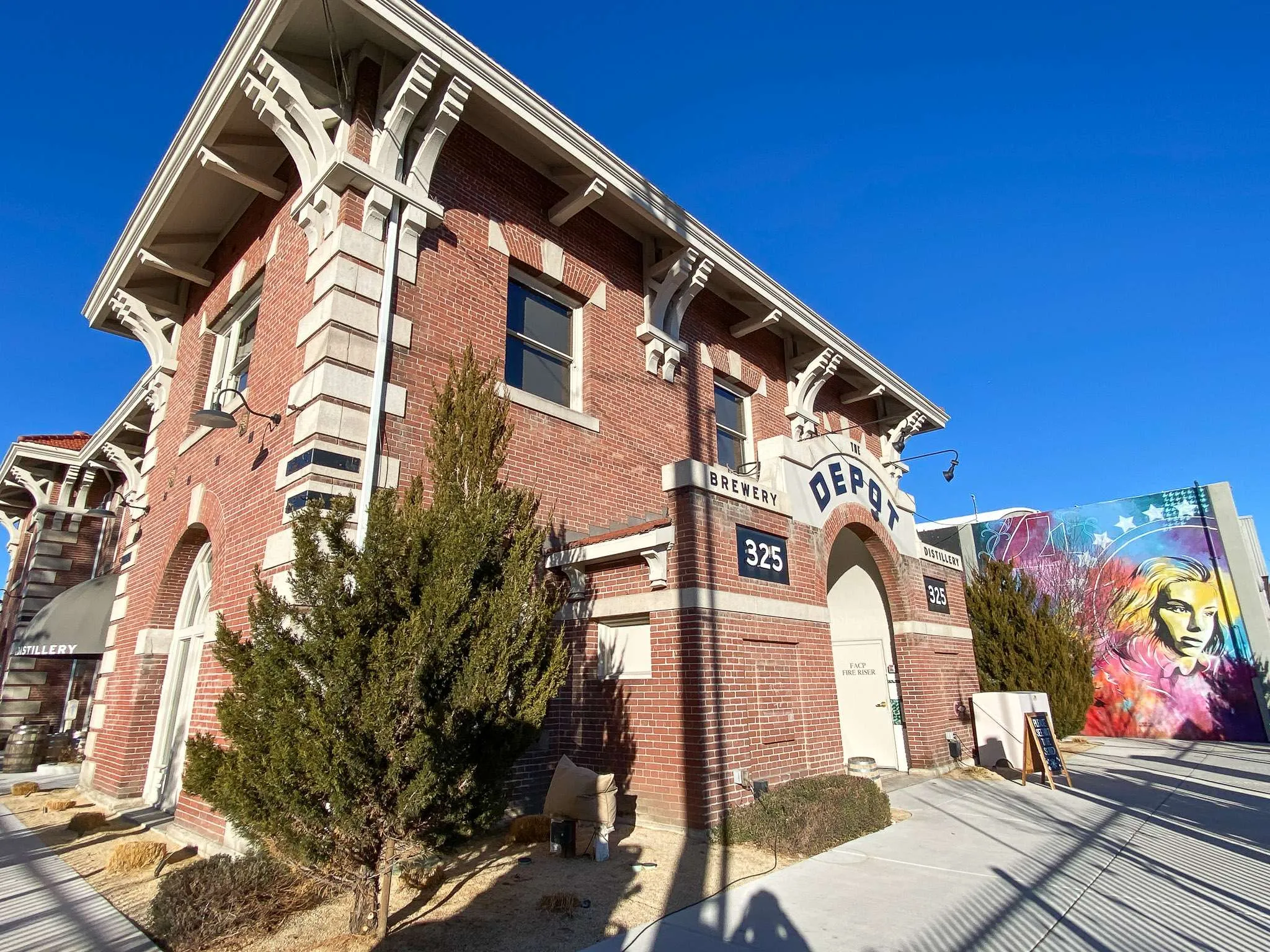
Historic black and white photo of NCO Railway Depot in Reno
Many of the sites I’ve explored on my journeys through this area are directly connected to this pioneering railway.
Milford: A Surviving Slice of Early Settlement
Milford, California, stands as one of the oldest settlements around Honey Lake, predating the N.C.O. by several decades, having been settled in 1856. Its early prosperity was tied to agriculture, with the first flour mill established in 1861. A post office opened in 1864, and the town quickly developed into a thriving community complete with mills, blacksmith shops, hotels, stores, and a schoolhouse.
Top 15+ Ideas for Unforgettable Family Fun Los Angeles
Discover the Best Backpacking in Michigan – Unforgettable Trails & Adventures
Discover the Best Time to Visit Denver – A Seasonal Guide 2025
 Rustic abandoned building in Milford, California, a ghost town near Reno
Rustic abandoned building in Milford, California, a ghost town near Reno
Milford’s long history has seen its share of challenges, including recently being threatened by the massive Dixie Fire. Fortunately, dedicated firefighters were able to save the historic area, preserving this fascinating window into the past for those exploring ghost towns near Reno.
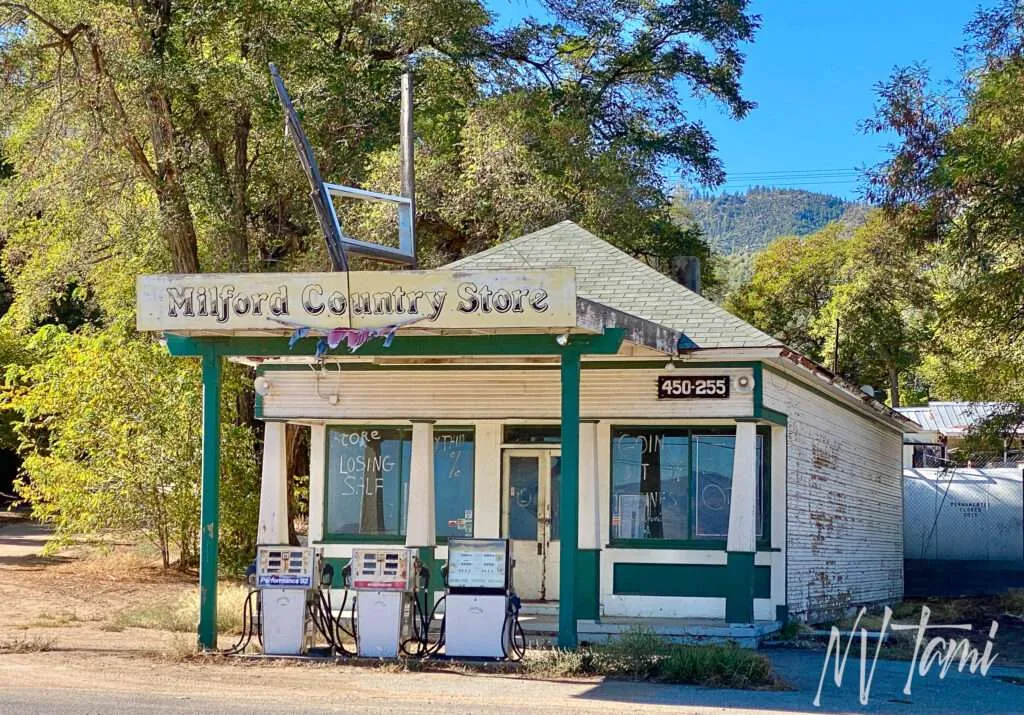 Weathered wooden building with porch in Milford, California
Weathered wooden building with porch in Milford, California
Standish: A Philosophical Experiment
Standish, California, offers a slightly different narrative from many other towns in the region, having been founded on philosophical ideals rather than solely mining, ranching, or transportation needs. Established in 1897, it was the second settlement for the Associated Colonies of New York, an ambitious project based on the principles of Myles Standish and the economic structure developed by Brigham Young.
The unique plan envisioned residents living centrally in town while venturing out daily to work the surrounding fields, a model reminiscent of European agricultural communities. To establish the Standish Colony, the new town actively recruited citizens from the existing Honey Lake Colonial Club.
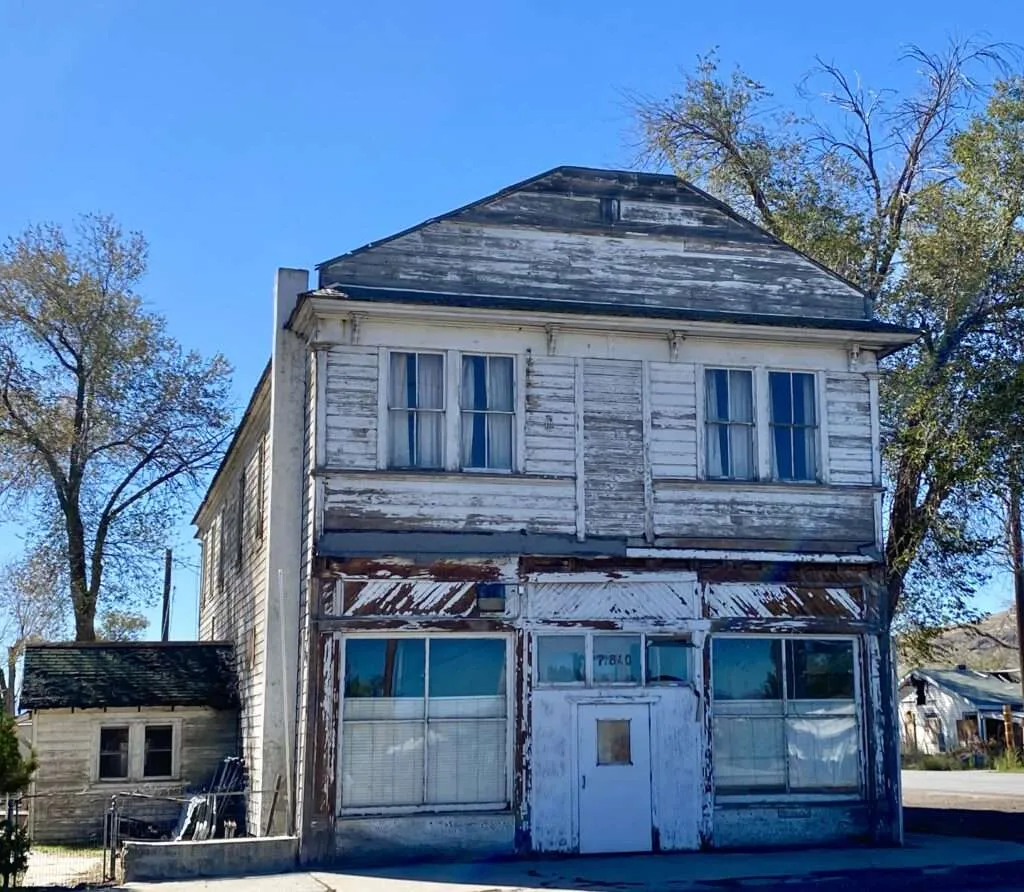 Historic Standish Hall building in Standish, California
Historic Standish Hall building in Standish, California
Despite facing legal battles over crucial water rights that hindered growth, Standish managed to open a post office in 1899. Standish Hall, built in 1907, served as a central hub, housing a store (Neils Mercantile) on the ground floor and providing a meeting space upstairs for various social groups. Neils Mercantile remained a vital part of the community well into the 1980s, offering everything from fresh meat to hardware.
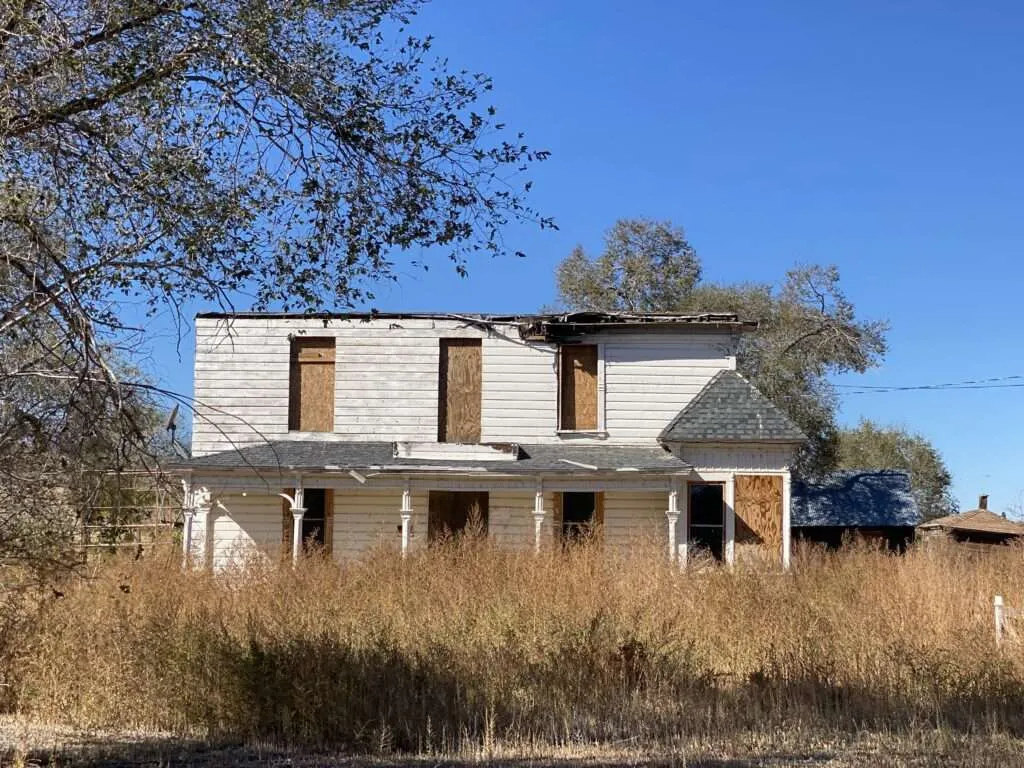 Side view of Standish Hall with trees and sky
Side view of Standish Hall with trees and sky
Litchfield: A Railroad Town’s Rise and Fall
Litchfield, California, directly owes its existence to the anticipation of railroad development. Founded in 1914, the town was established with the expectation of the Fernley & Lassen Railway’s arrival. While the railroad line itself reached Litchfield in 1913, a dedicated station didn’t open until three years later.
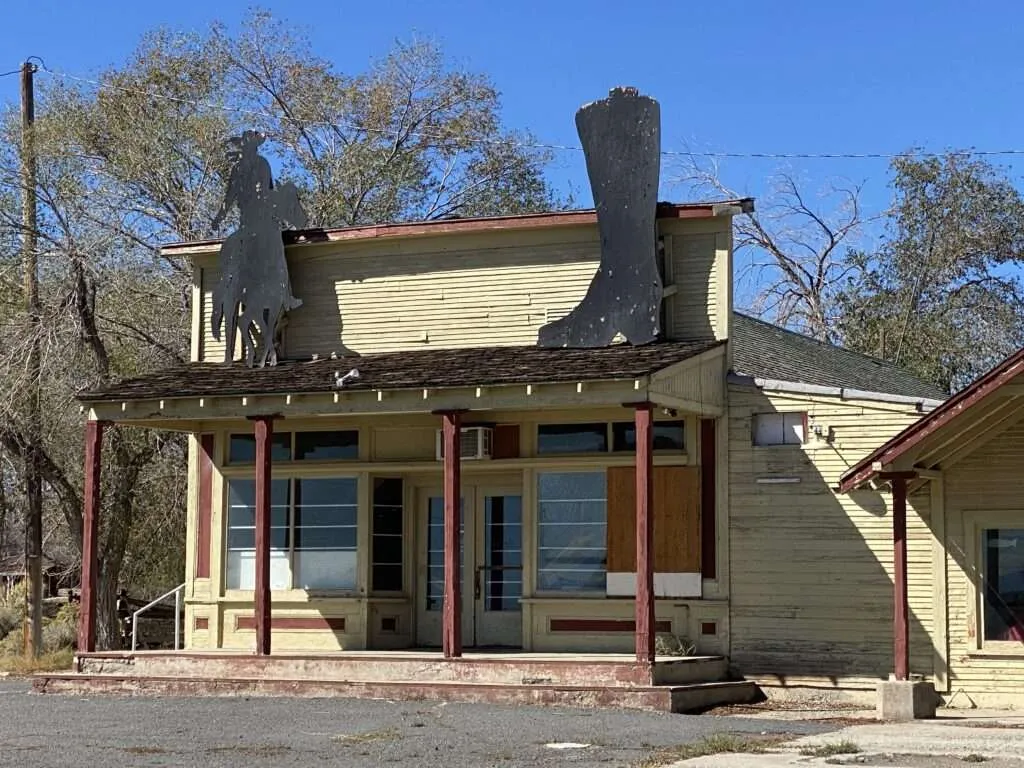 Building with signage “Heard’s Market” in Litchfield, California
Building with signage “Heard’s Market” in Litchfield, California
Litchfield quickly became a significant shipping hub, a role it maintained until 1954 when the depot was finally closed. Businesses like Heard’s Market, which opened in 1948, catered to the local community and ranchers, selling everything from groceries to ranch supplies and cowboy boots. Today, remnants of its railroad past and local businesses offer a glimpse into this period of its history.
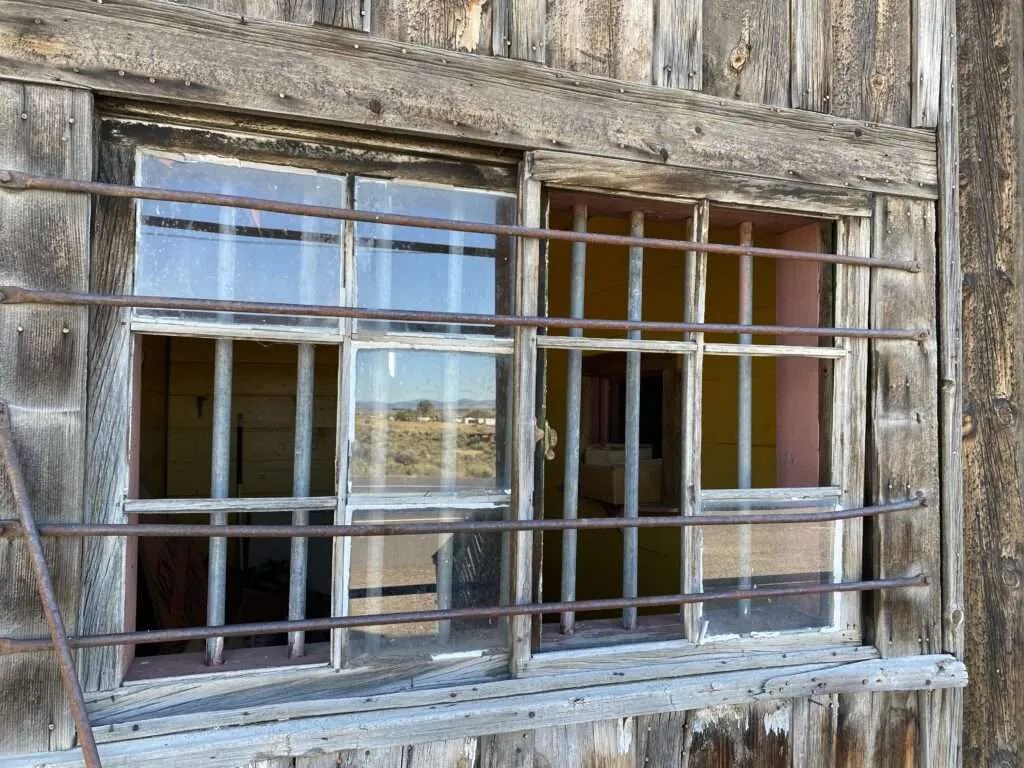 View of railway tracks near abandoned buildings in Litchfield, California
View of railway tracks near abandoned buildings in Litchfield, California
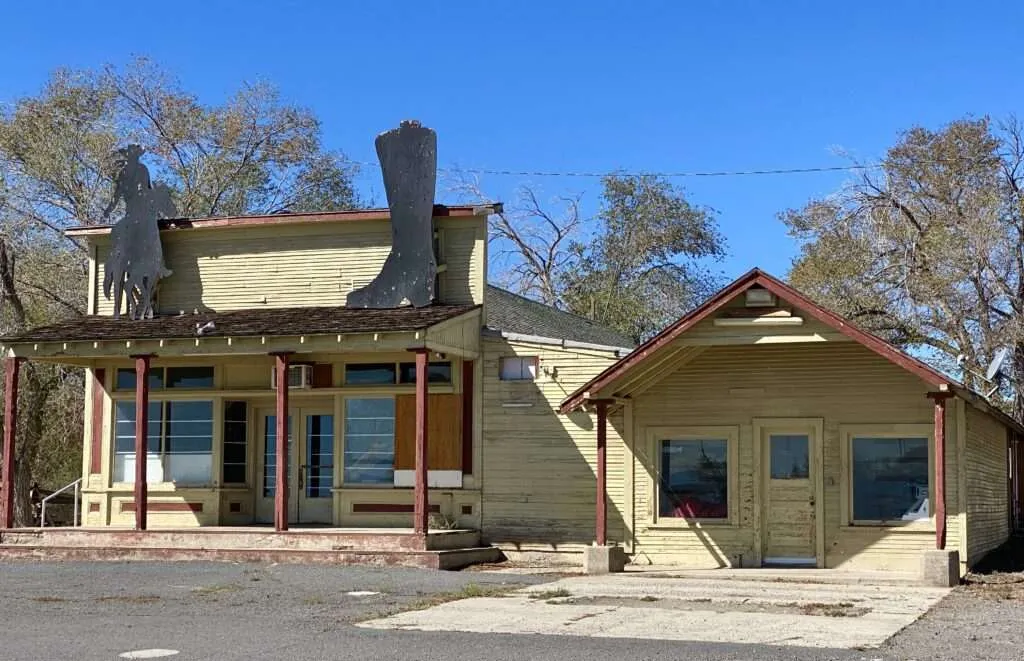 Heard’s Market sign close up
Heard’s Market sign close up
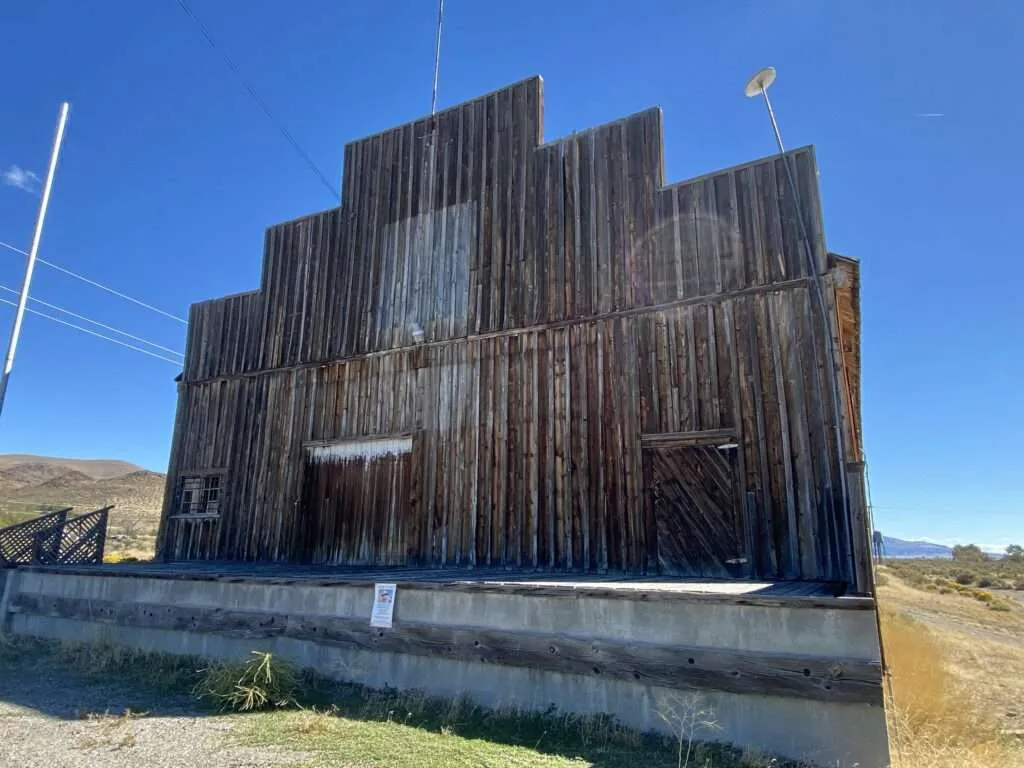 Building with “Honey Lake Feed” sign in Litchfield
Building with “Honey Lake Feed” sign in Litchfield
Dayton/Lathrop City: Bypassed by Progress
The small settlement initially known as Lathrop City began as a station along the historic Nobles Emigrant Trail, established by George Lathrop and Thomas Harvey. The partners sold the station in 1862, and it was renamed Shaffer’s Station by the new owners, the Shaffers. Anticipating the continued flow of emigrants and the eventual arrival of the Transcontinental Railroad, a townsite was platted.
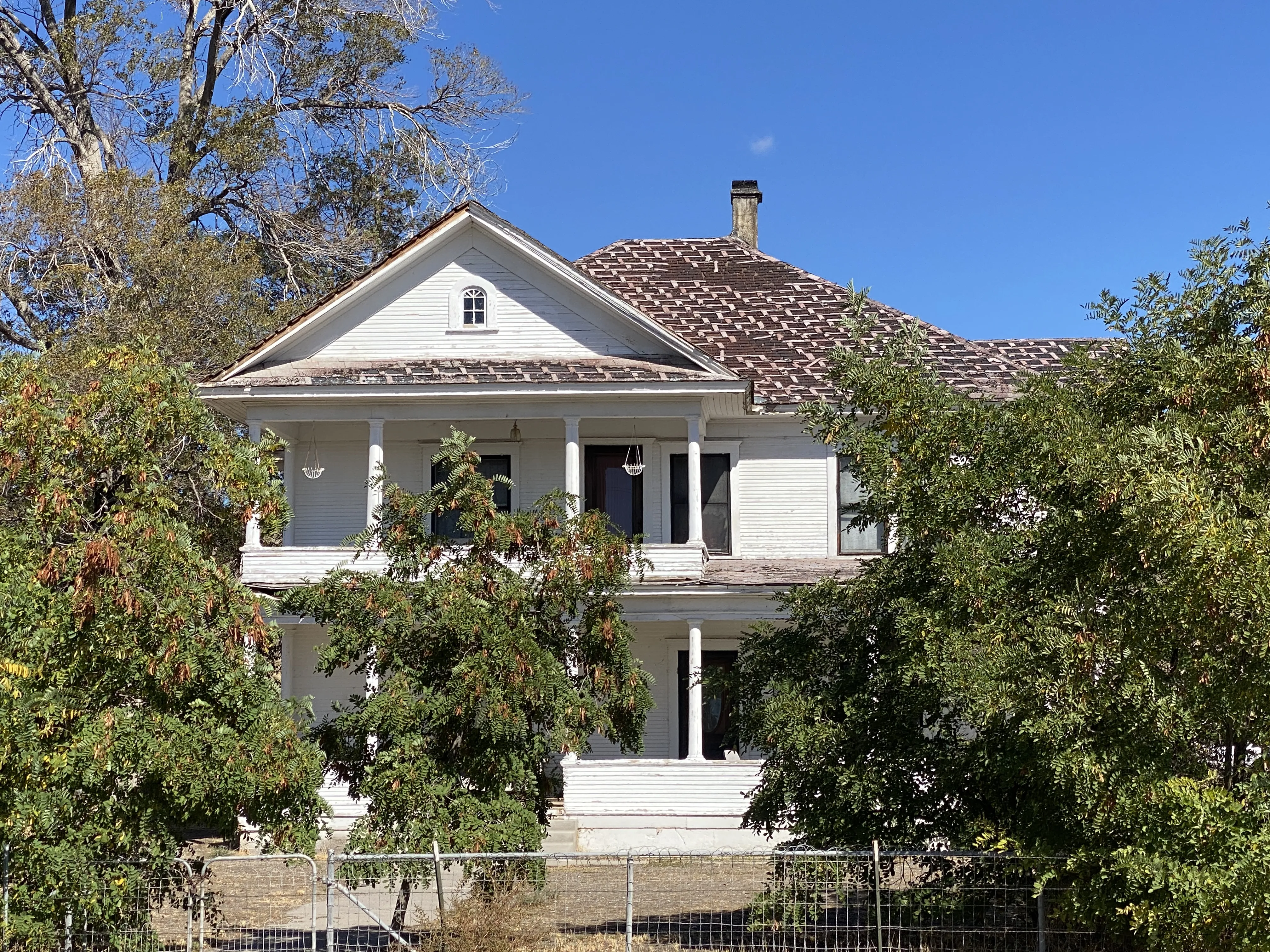 Exterior view of an old abandoned building in Dayton/Lathrop City area
Exterior view of an old abandoned building in Dayton/Lathrop City area
A post office opened in 1873 under the name Dayton. However, the critical blow came when the Transcontinental Railroad took a different route, bypassing the planned town entirely. Without the expected rail connection and emigrant traffic dwindling, Dayton faltered, and the post office closed just two years later in 1875. Today, exploring the area reveals the quiet solitude of a place whose ambitions were undone by a turn of the tracks.
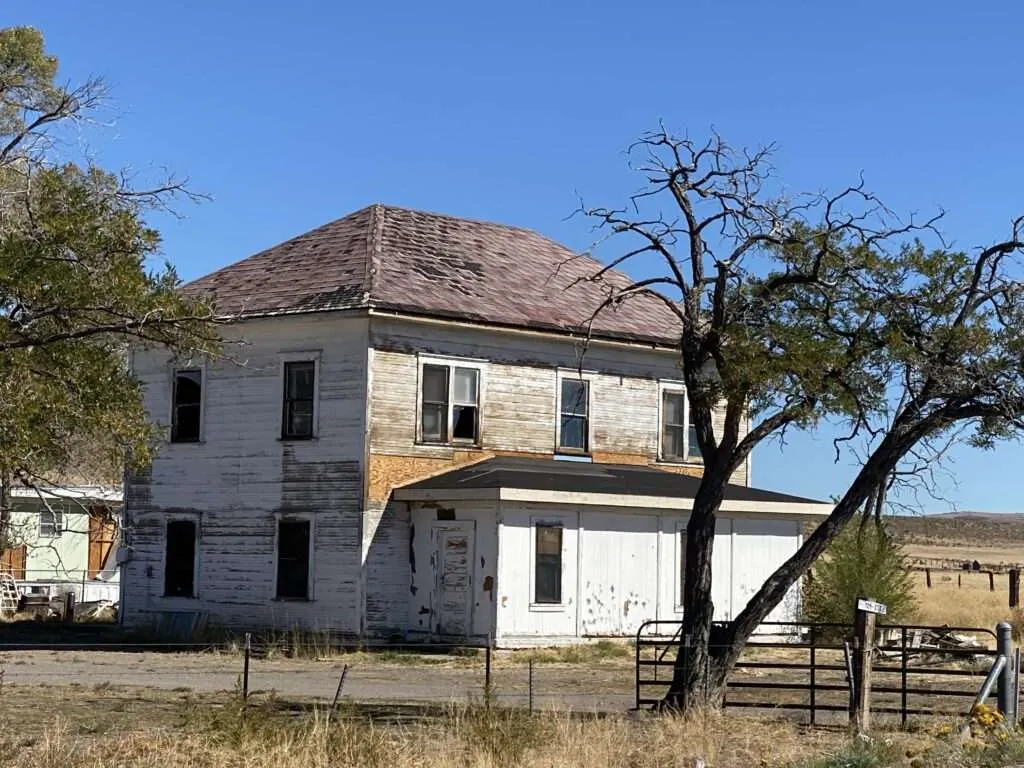 Another view of an old building in Dayton/Lathrop City
Another view of an old building in Dayton/Lathrop City
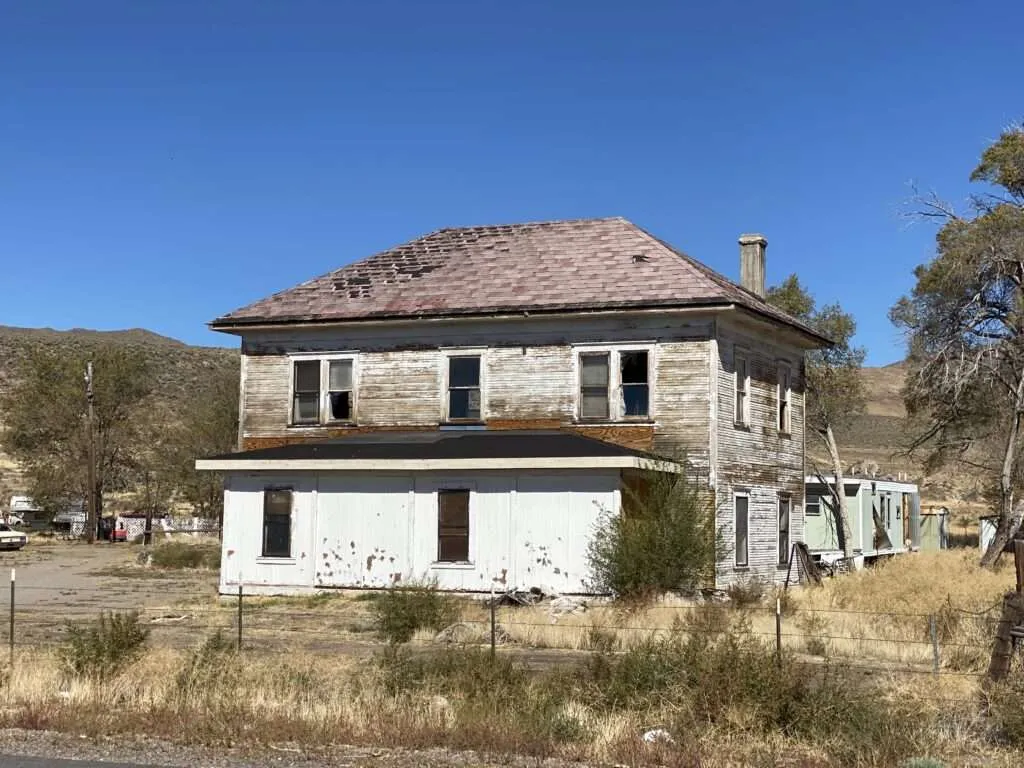 Interior view of a room in an abandoned building
Interior view of a room in an abandoned building
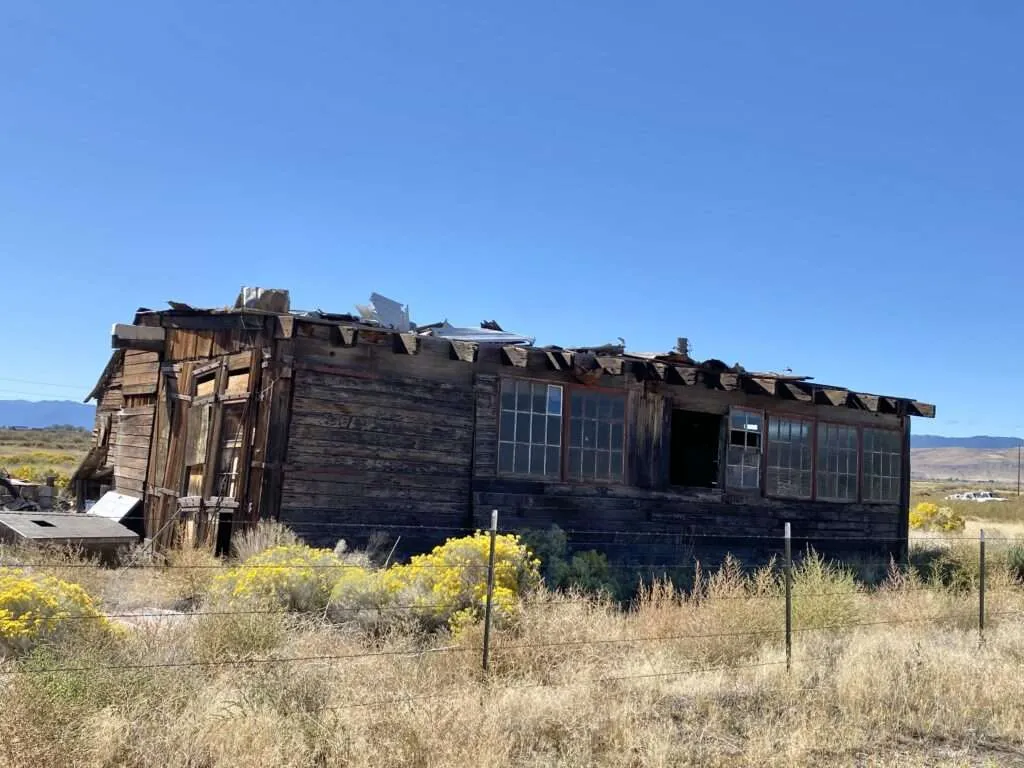 Exterior of small abandoned shack
Exterior of small abandoned shack
 Another exterior shot of a different angle of a building
Another exterior shot of a different angle of a building
Wendel: A Town of Many Names
Wendel, California, was an unplanned detour that turned into a highlight. Spotting a distinctive railroad water tower, I decided to investigate, and I was rewarded with one of my favorite stops on this trip exploring ghost towns near Reno. Wendel holds the distinction of possibly having changed names more times than any other town in the area. Chronologically, it was known as Upper Hot Springs, Schaeffer Hot Springs, Smithon, Boyd, Hot Springs Station, Purser, Antola, Caloreta, before finally settling on Wendel.
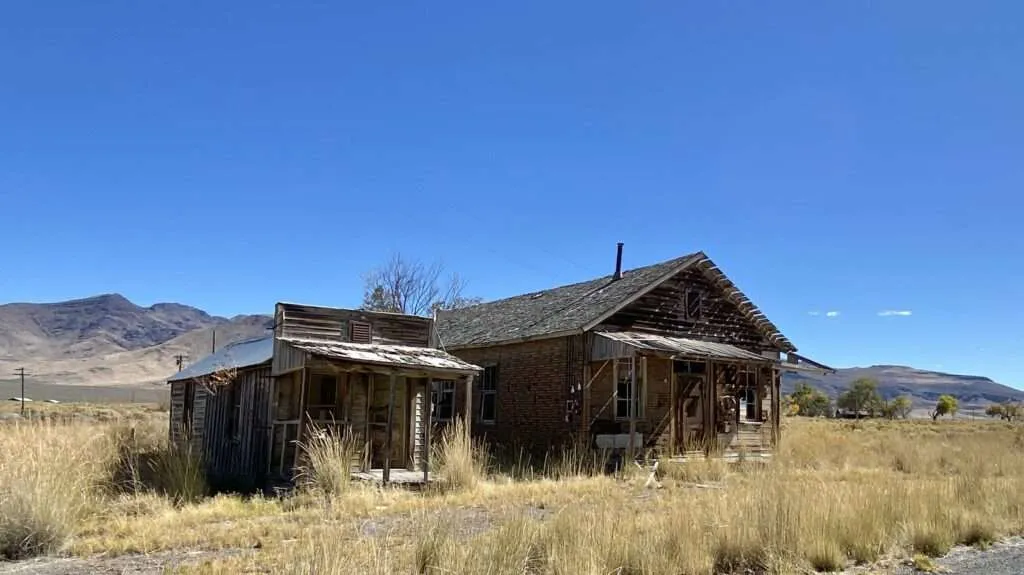 Abandoned buildings along a street in Wendel, California ghost town near Reno
Abandoned buildings along a street in Wendel, California ghost town near Reno
Adding to the naming confusion, there was also a brief stop named Wendel in Lake County, Oregon, along the same N.C.O. line. Both towns were named in honor of a friend and significant investor of Thomas Moran, the President of the N.C.O.
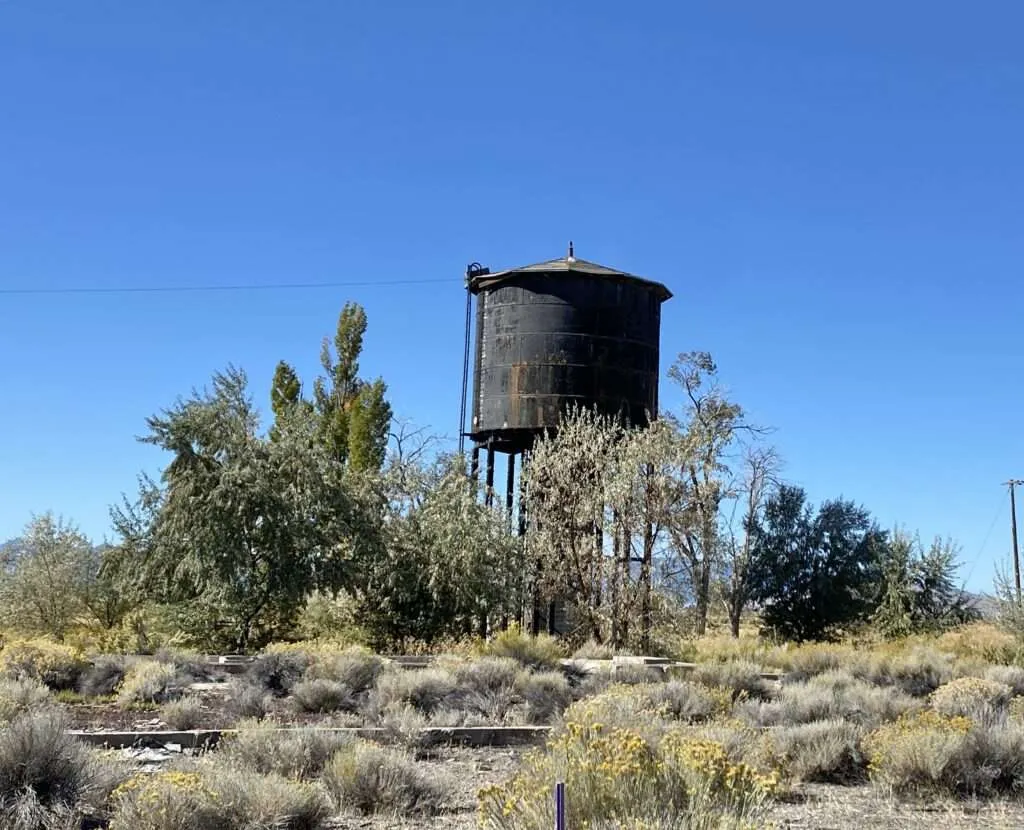 Tall railroad water tower in Wendel, California ghost town near Reno
Tall railroad water tower in Wendel, California ghost town near Reno
Wendel California was a crucial station for the N.C.O., serving as the junction for the Susanville branch and a place where train crews would change. The town featured essential railway infrastructure, including an engine house, the prominent water tower, and a powerhouse. Its importance faded with the decline of the railway and changing transportation methods. The post office closed on December 3, 1993, and the rails were eventually removed, leaving behind a hauntingly quiet landscape.
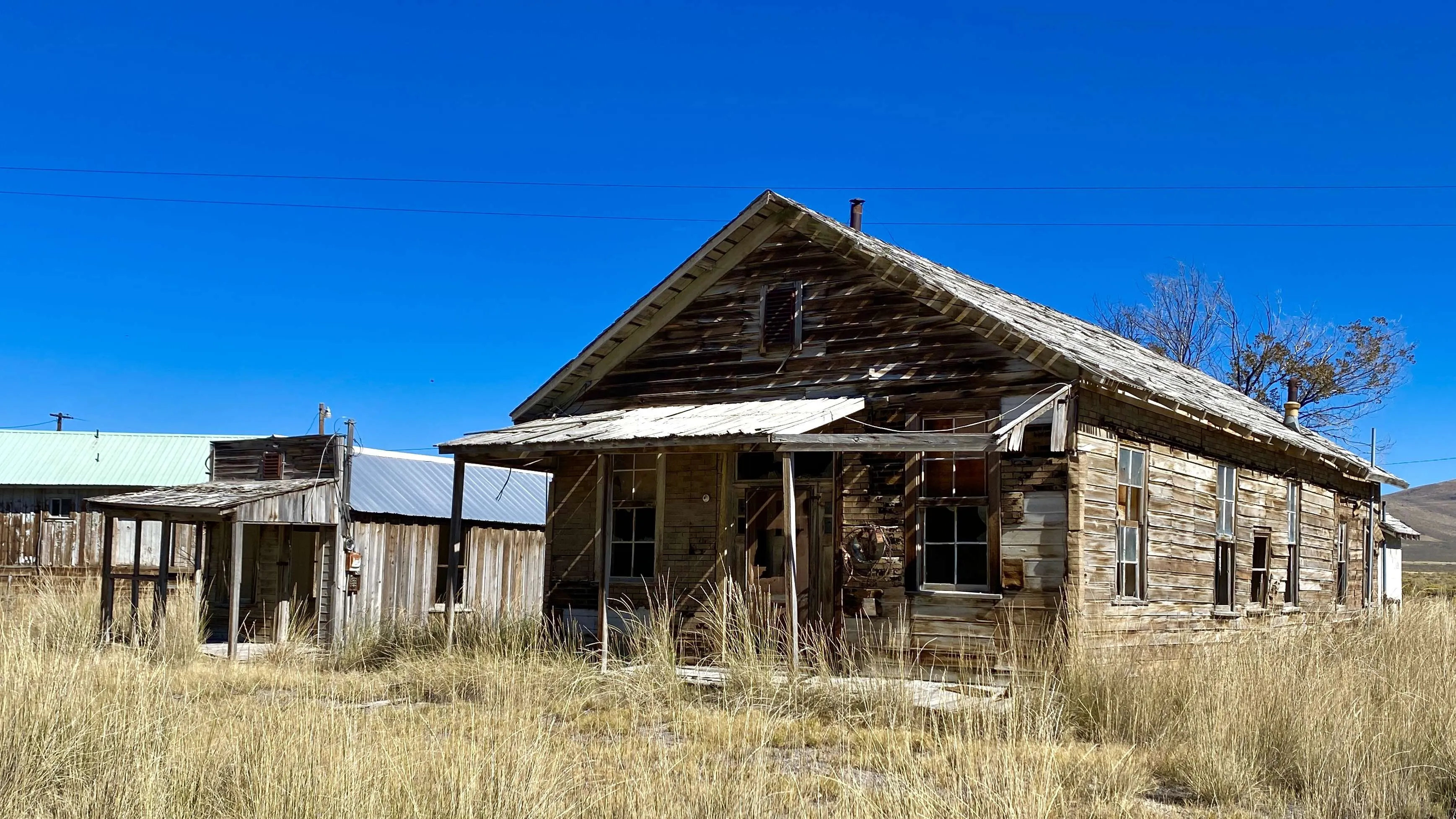 Main street view of downtown Wendel ghost town near Reno
Main street view of downtown Wendel ghost town near Reno
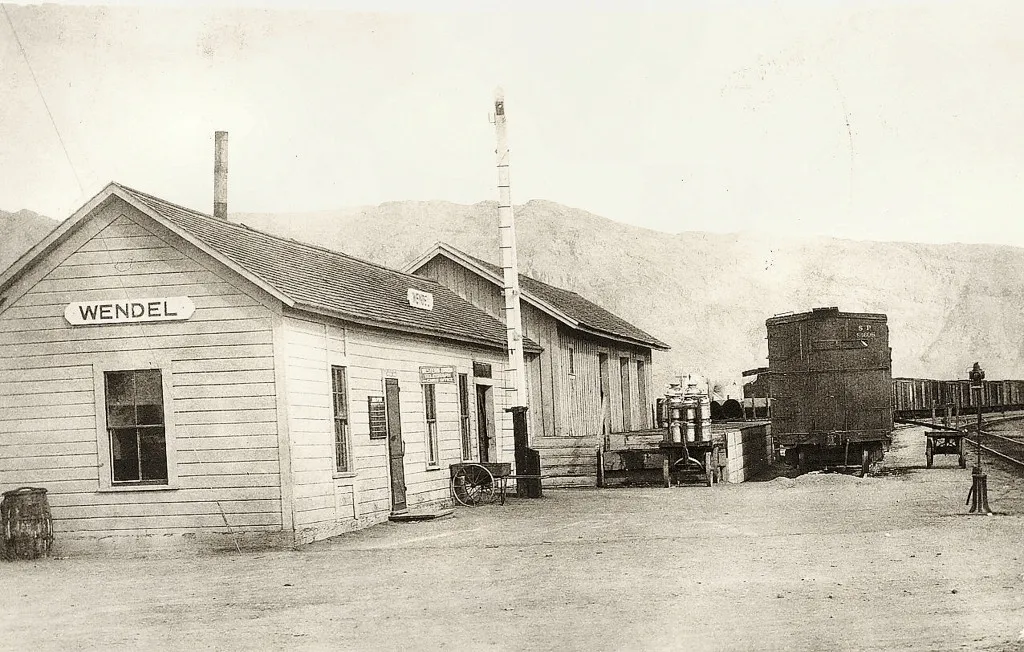 Historic photo of buildings in Wendel, California
Historic photo of buildings in Wendel, California
Driving further down the road from what remains of Wendel, I encountered one of the more unsettling areas on my journey – a place that truly felt like something out of a “Hoarders: Ghost Town Edition” episode. Debris was everywhere, covering parts of the road, and while I could hear a dog in the distance, indicating some nearby inhabitants, the atmosphere was distinctly eerie. It was a stark reminder that not all abandoned places are perfectly preserved historical sites; some fade into disarray in ways that are less picturesque but equally evocative.
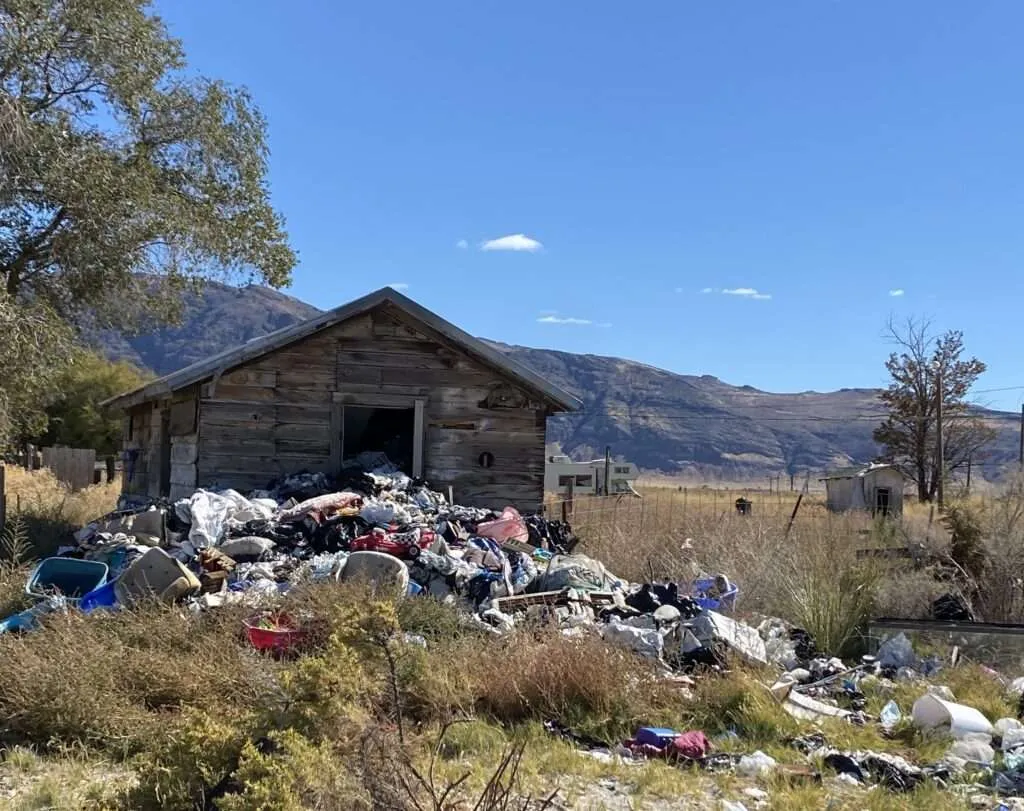 Debris and trash scattered along a road in the outskirts of Wendel
Debris and trash scattered along a road in the outskirts of Wendel
 Close-up of graffiti on abandoned wall in Wendel
Close-up of graffiti on abandoned wall in Wendel
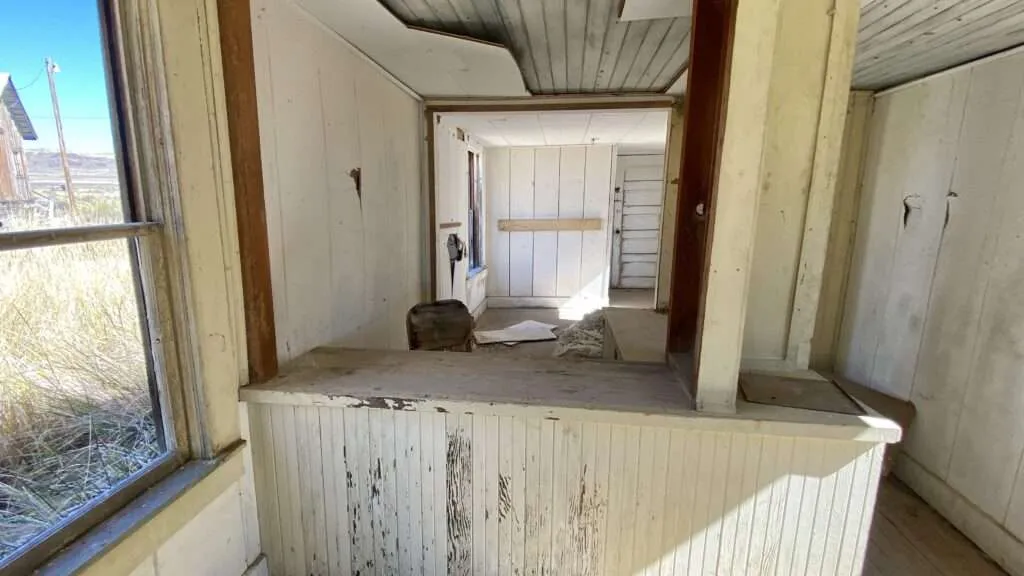 View of abandoned buildings with trees and sky
View of abandoned buildings with trees and sky
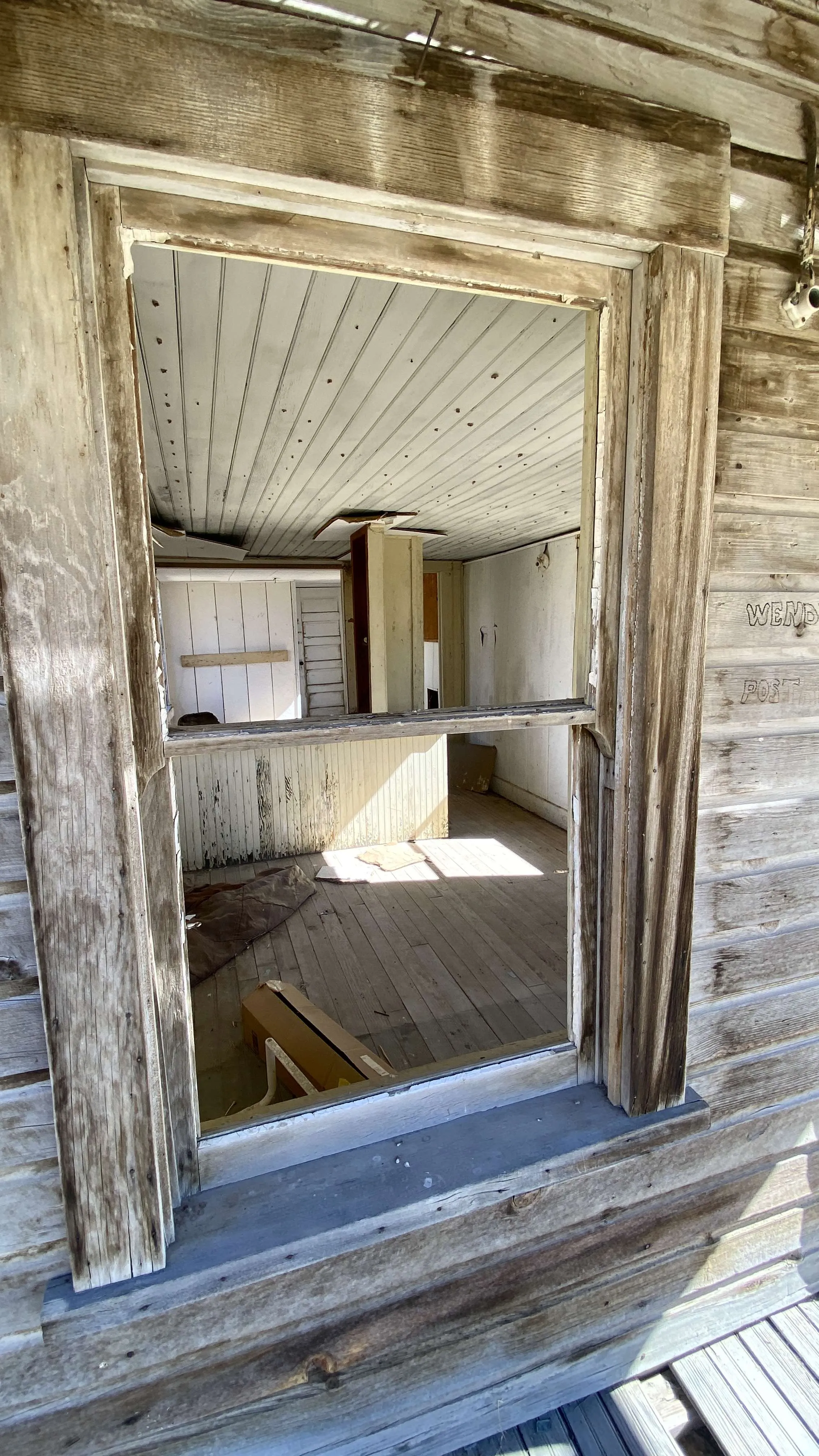 Another angle of abandoned buildings in Wendel
Another angle of abandoned buildings in Wendel
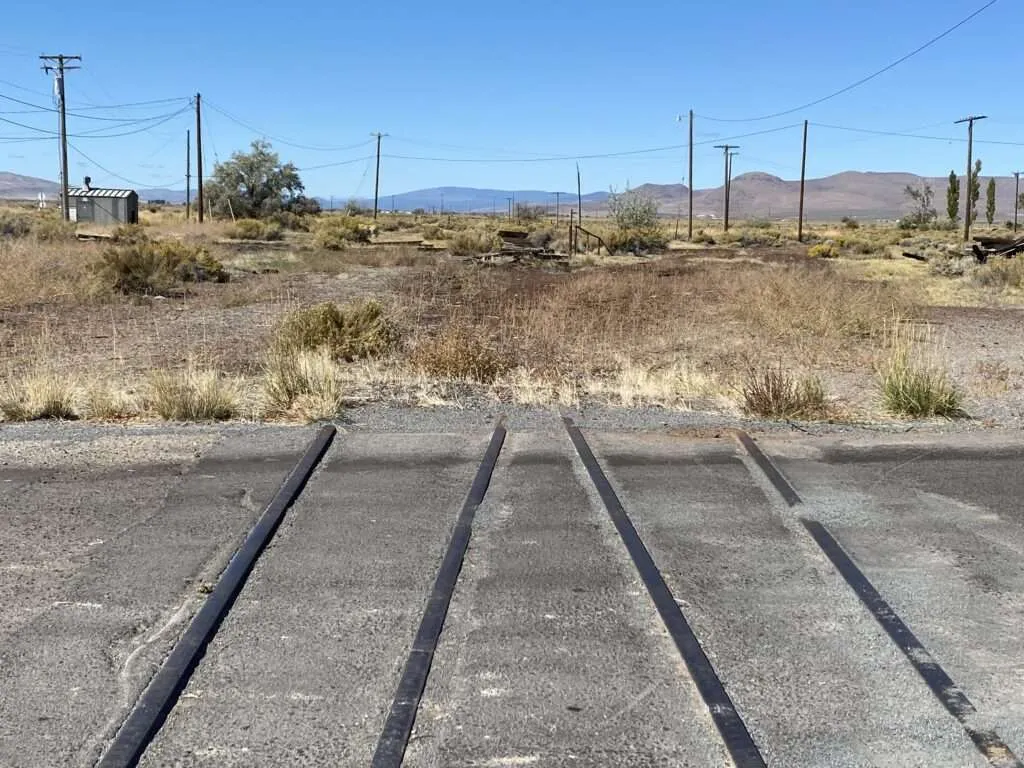 Empty lot with scattered rubble and weeds
Empty lot with scattered rubble and weeds
Amedee: A Terminal’s History and a Significant Kiln
Amedee, California, was a primary planned stop on this trip, specifically to see its historic lime kiln. However, research revealed Amedee’s own significant history as a town in Lassen County. Named after Amedee Depau Moran, one of the N.C.O. owners, it served as a key terminal for the railway. Though little marks the original townsite today, it was once a vibrant community that even competed with Susanville for the county seat after a major fire there in 1893.
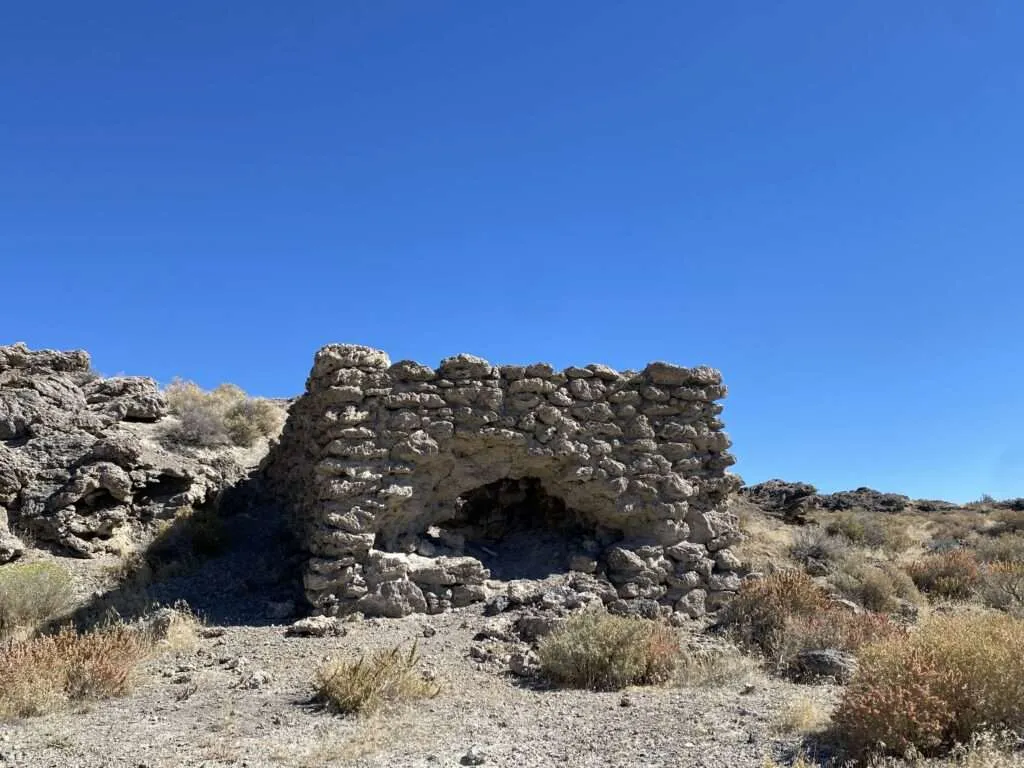 Remains of the Amedee lime kiln near the ghost town site near Reno
Remains of the Amedee lime kiln near the ghost town site near Reno
Between the 1890s and early 1900s, Amedee was a major shipping center for ranchers and dairymen, leveraging both the railroad and steamboat traffic across Honey Lake. It even boasted a post office from 1890 to 1924. Beyond its industrial importance, Amedee was a destination town offering hot springs, saloons, gambling, and outdoor recreation, including paddle boating on Honey Lake. Its decline was sealed when the N.C.O. terminal was moved to nearby Wendel. In a fascinating twist of fate, the entire town was purchased for a mere $32.15 by Jack and Margaret Humphrey in 1950 during a tax sale, as they were the only bidders.
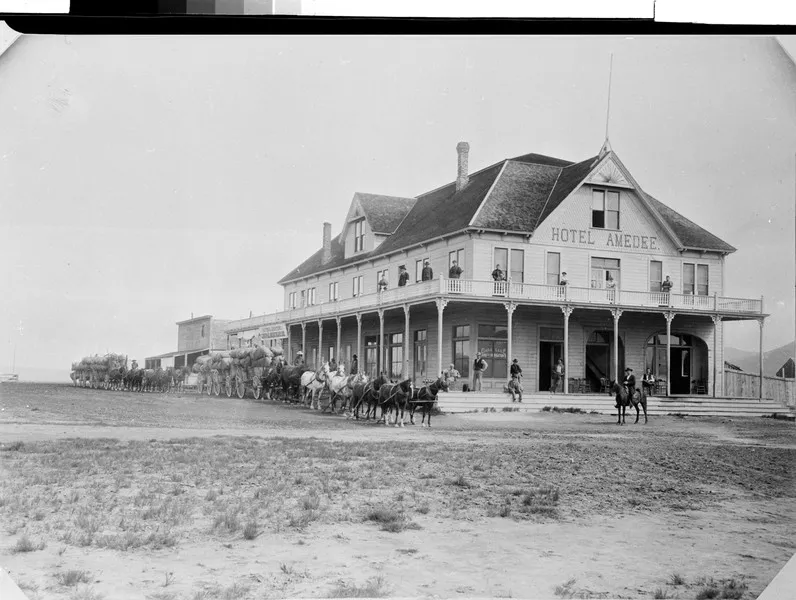 Historic photo of Hotel Amedee
Historic photo of Hotel Amedee
The Amedee Kiln: A Relic of Industry
The Amedee Lime Kiln is a striking example of the industrial processes that supported the growth of the West. Lime, a crucial material derived from stones like limestone and travertine, requires baking in a kiln to be extracted. In the early 1890s, the Amedee Lime Works shipped raw limestone to Reno for processing.
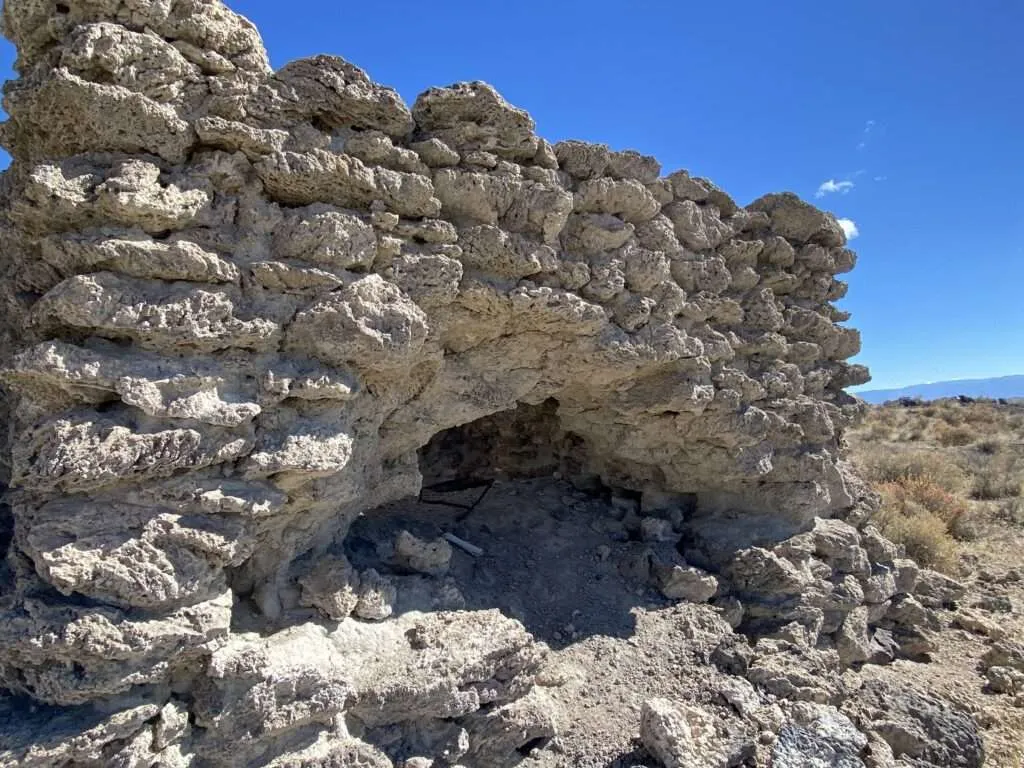 Exterior view of the Amedee lime kiln, highlighting construction details
Exterior view of the Amedee lime kiln, highlighting construction details
Seeking to streamline the process, Charley Falding constructed the stone kiln at Amedee in 1893 to process the lime on-site. Operations continued into the 1920s, but despite the high quality of the local stone, the remote location and challenges related to shipping ultimately made the Amedee Kiln’s operation unsustainable. Today, the substantial stone structure remains a powerful reminder of the area’s industrial past and is a must-see for anyone visiting ghost towns near Reno with an interest in history.
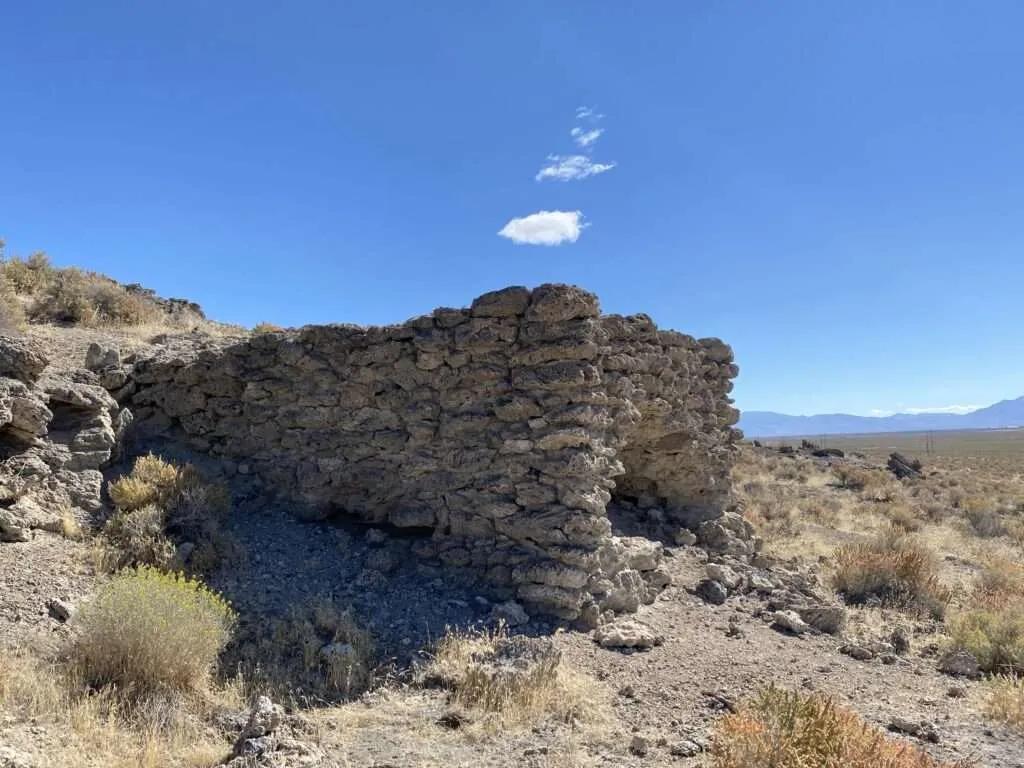 Interior view looking up into the Amedee lime kiln
Interior view looking up into the Amedee lime kiln
Lunch with History
Exploring ghost towns and historical sites tends to build an appetite! Faced with the choice of stopping at a restaurant in Alturas or having lunch right there at the Amedee lime kiln, the historical site won hands down. There’s something uniquely satisfying about enjoying a meal surrounded by such tangible history.
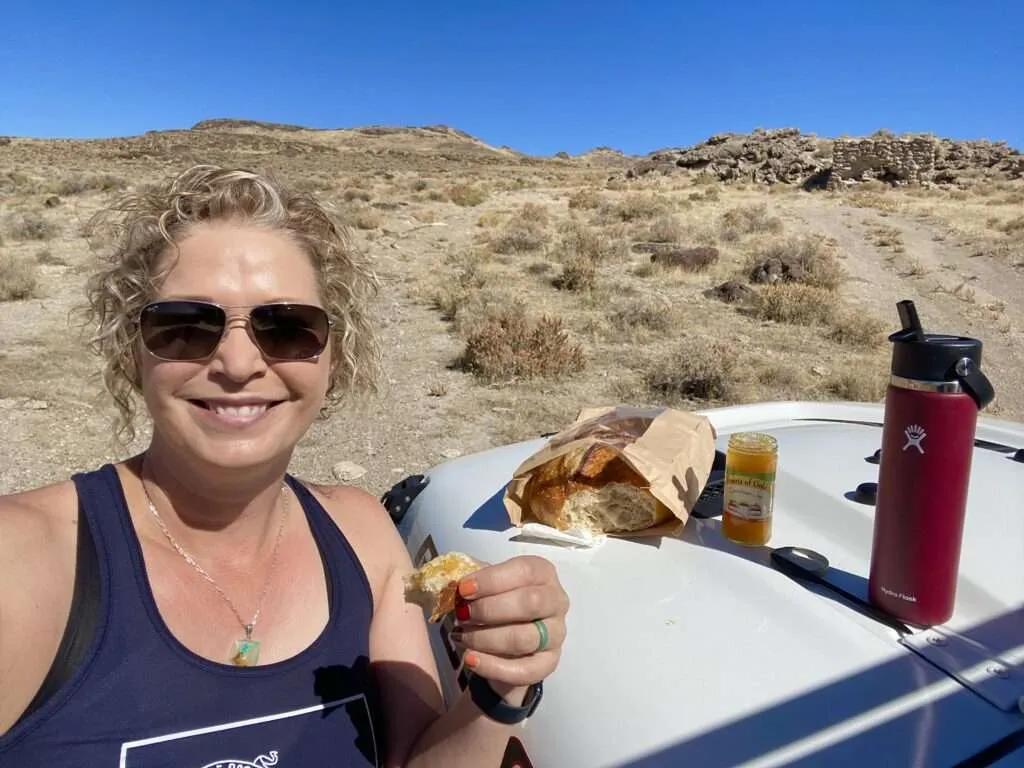 Lunch spread laid out on the hood of a vehicle near the Amedee kiln
Lunch spread laid out on the hood of a vehicle near the Amedee kiln
My meal was made even more special by a generous basket of local goodies I received after giving a presentation at the Churchill County Museum the night before my trip. Instead of my usual prepackaged snacks, I had the pleasure of enjoying delicious Battle Born Bread paired with Lattin Farms’ unique Hearts of Gold cantaloupe jam. The bread was perfectly crispy outside and soft inside, and the cantaloupe jam, which sounds unusual, was surprisingly delightful – not too sweet, with a subtle hint of melon, reminding me slightly of peach jelly. It was a perfect local flavor complement to a day steeped in regional history.
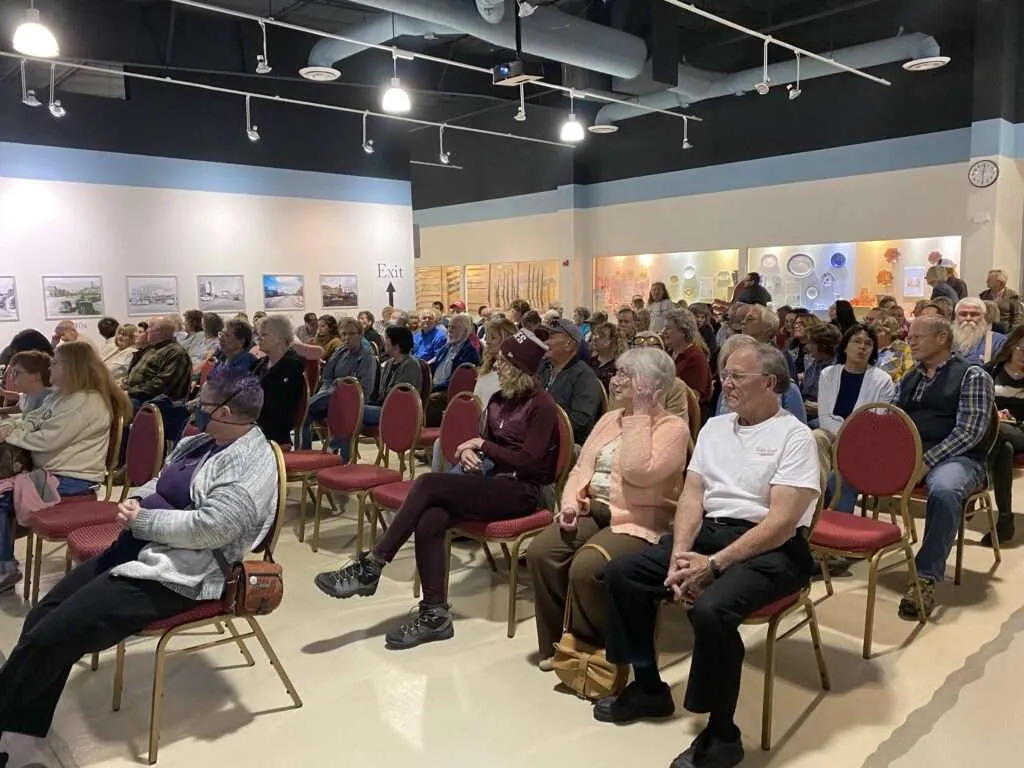 Photo of a presentation screen at Churchill County Museum
Photo of a presentation screen at Churchill County Museum
 Gift basket filled with local goodies
Gift basket filled with local goodies
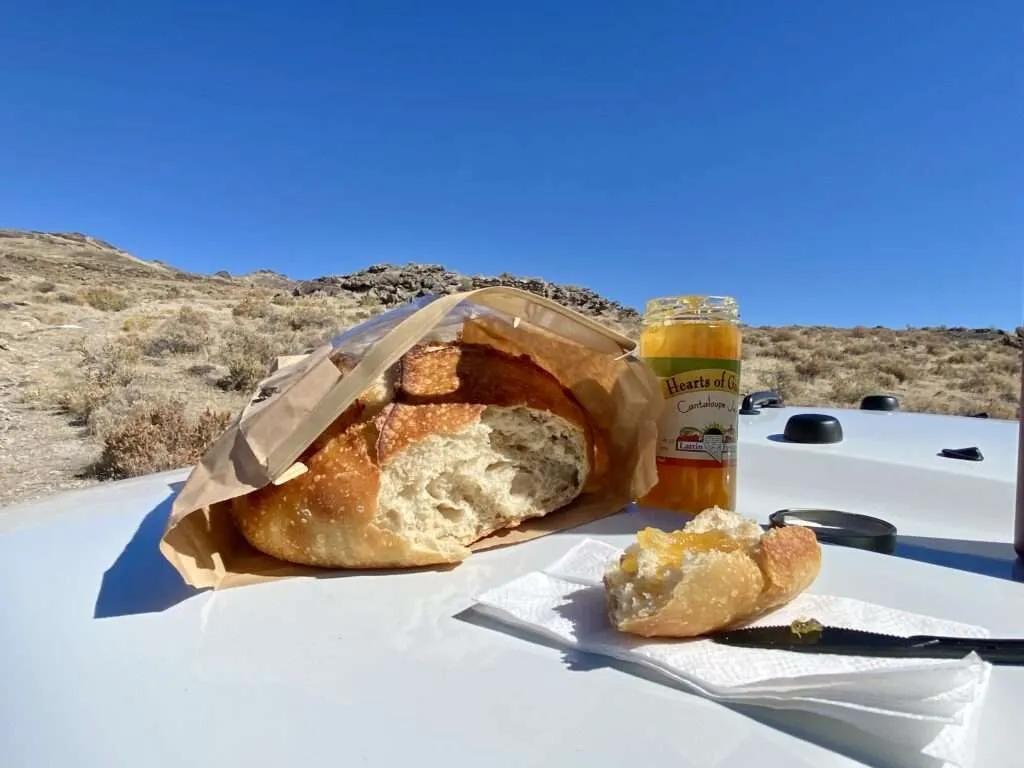 Close-up of Battle Born Bread and cantaloupe jam
Close-up of Battle Born Bread and cantaloupe jam
Ravendale: An Unsettling Stop
Ravendale, California, I confess, has a slightly unsettling atmosphere for me. Perhaps it’s the main building in town, a church housed within an old motor inn, or maybe the general quietude. The town’s history includes a curious legal case in 1939 when student attendance at Ravendale Elementary dropped to zero, leading the school trustees to question paying the teacher’s salary. The California Attorney General ultimately ruled that payment was still required.
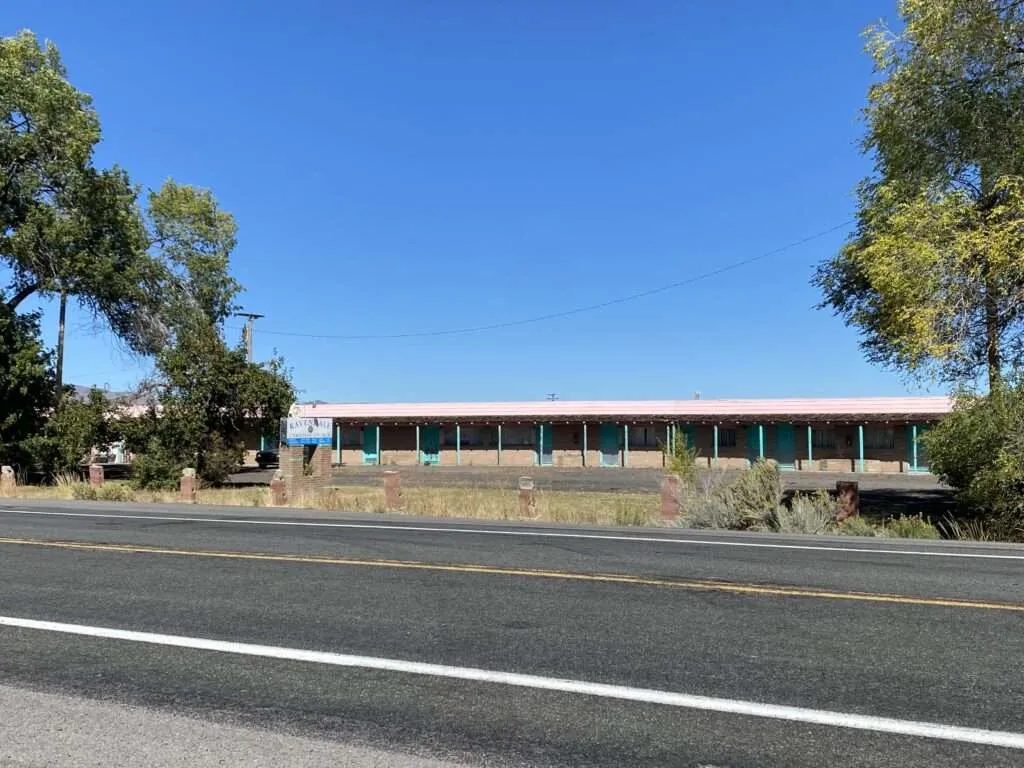 Former motor inn building now housing Ravendale Christian Church
Former motor inn building now housing Ravendale Christian Church
Ravendale also served as a station on the N.C.O., with a post office operating intermittently from 1910 to 1920, and again in 1921. The town was named for the significant number of ravens in the area, a detail that, for me, only adds to the slightly eerie feeling of the place. The old Ravendale motel operated in the 1950s, and while it now houses the church, it doesn’t project a particularly welcoming vibe for casual visitors.
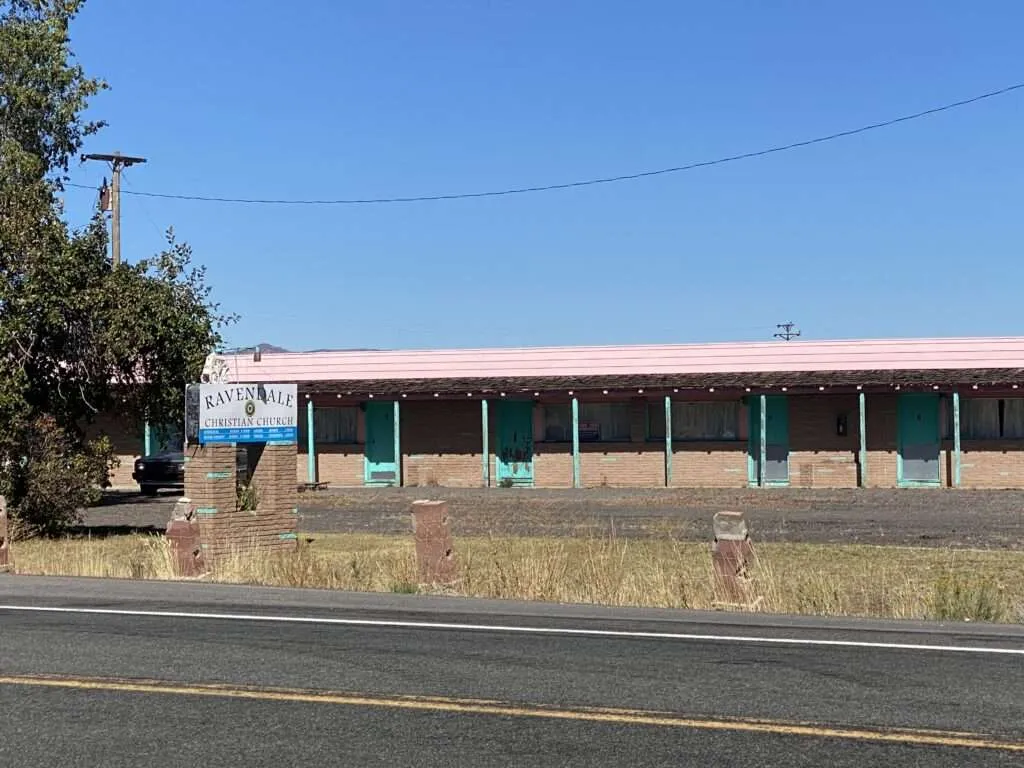 Exterior view of abandoned buildings in Ravendale, California ghost town
Exterior view of abandoned buildings in Ravendale, California ghost town
Termo: The End of the Line (For a Time)
Termo, California, fittingly derived its unusual name from its initial role as the terminus of the N.C.O. line in 1900. A post office was established here in 1908, reflecting its importance as the temporary end of the railway’s expansion. However, once the N.C.O. line was extended further north to Madeline and then on to Lakeview, Termo lost its strategic position and gradually faded into a ghost town. Today, it stands as a quiet reminder of its brief moment as the “end of the line.”
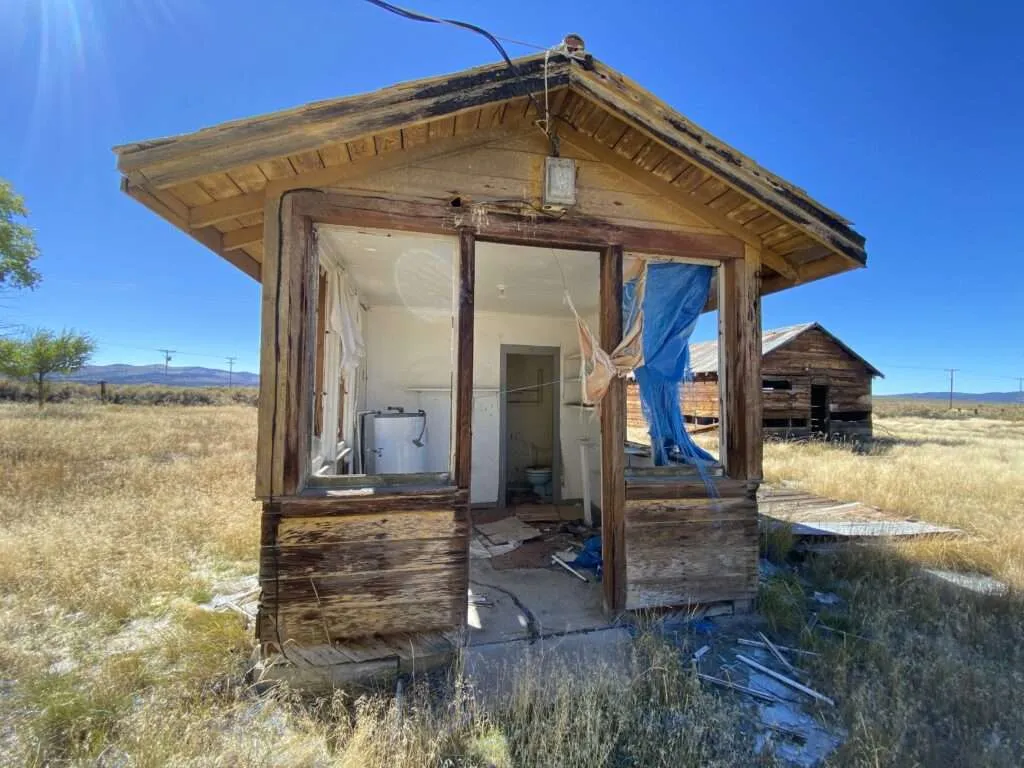 Abandoned house or building in Termo, California ghost town
Abandoned house or building in Termo, California ghost town
Exploring Termo offers a glimpse into the transient nature of railroad towns, whose fate was often tied directly to the changing path and reach of the tracks.
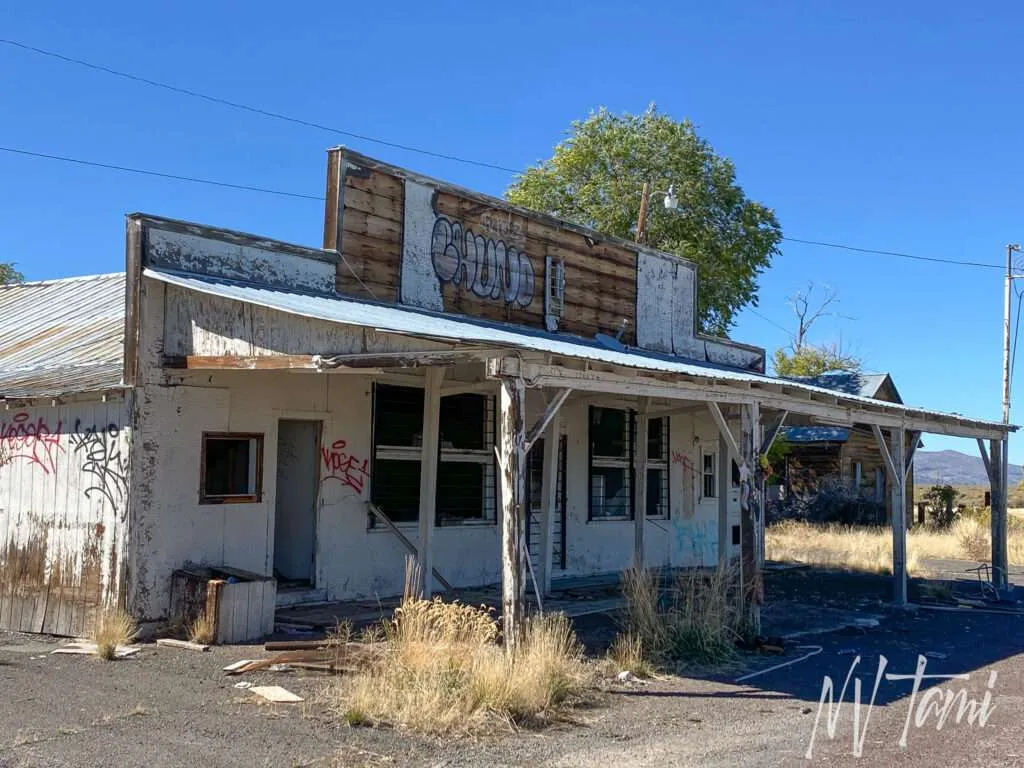 Exterior of another abandoned building in Termo
Exterior of another abandoned building in Termo
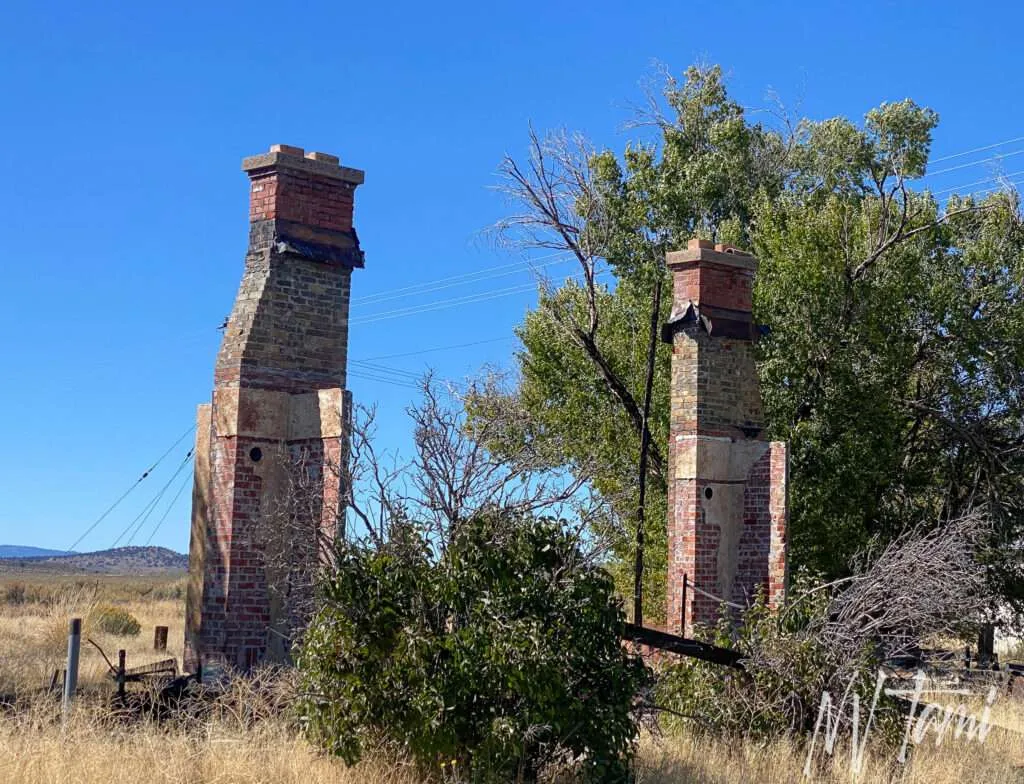 Close-up on a detail of an old door or window
Close-up on a detail of an old door or window
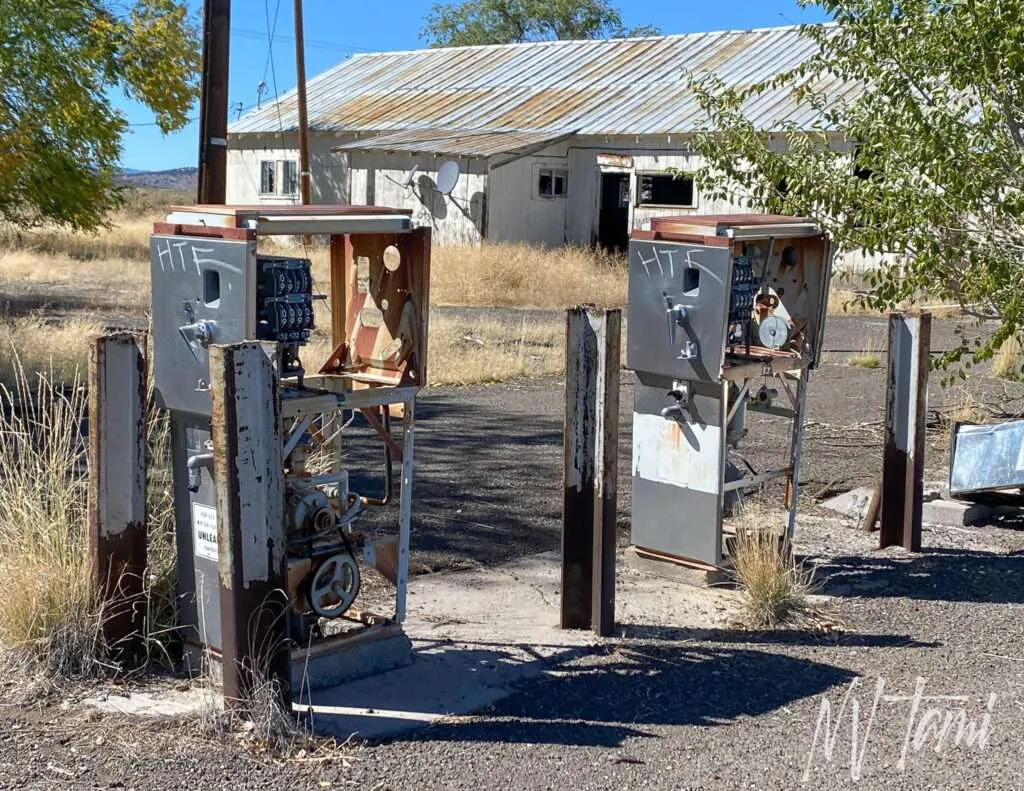 Exterior view of a different abandoned house in Termo
Exterior view of a different abandoned house in Termo
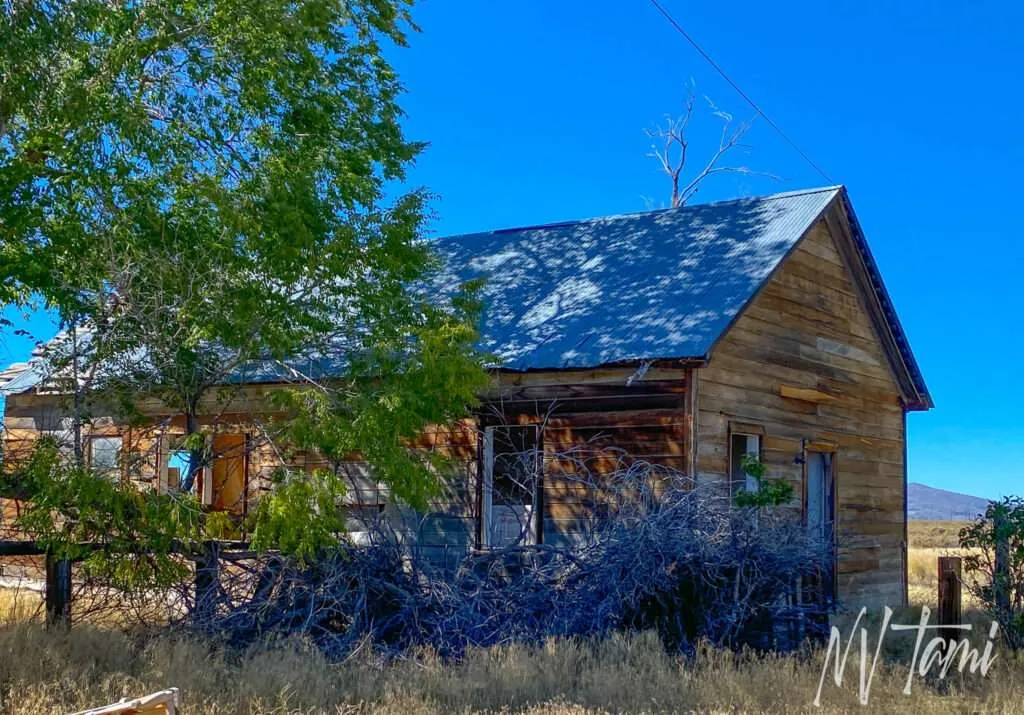 View down a road with abandoned buildings
View down a road with abandoned buildings
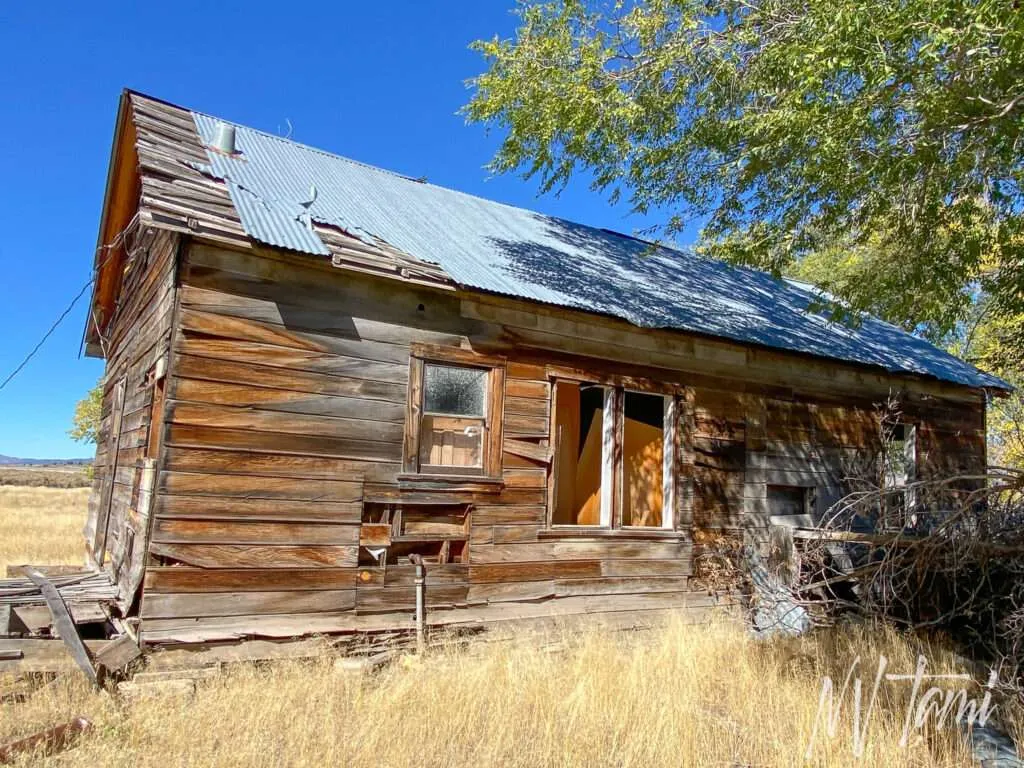 Another view of an abandoned house with peeling paint
Another view of an abandoned house with peeling paint
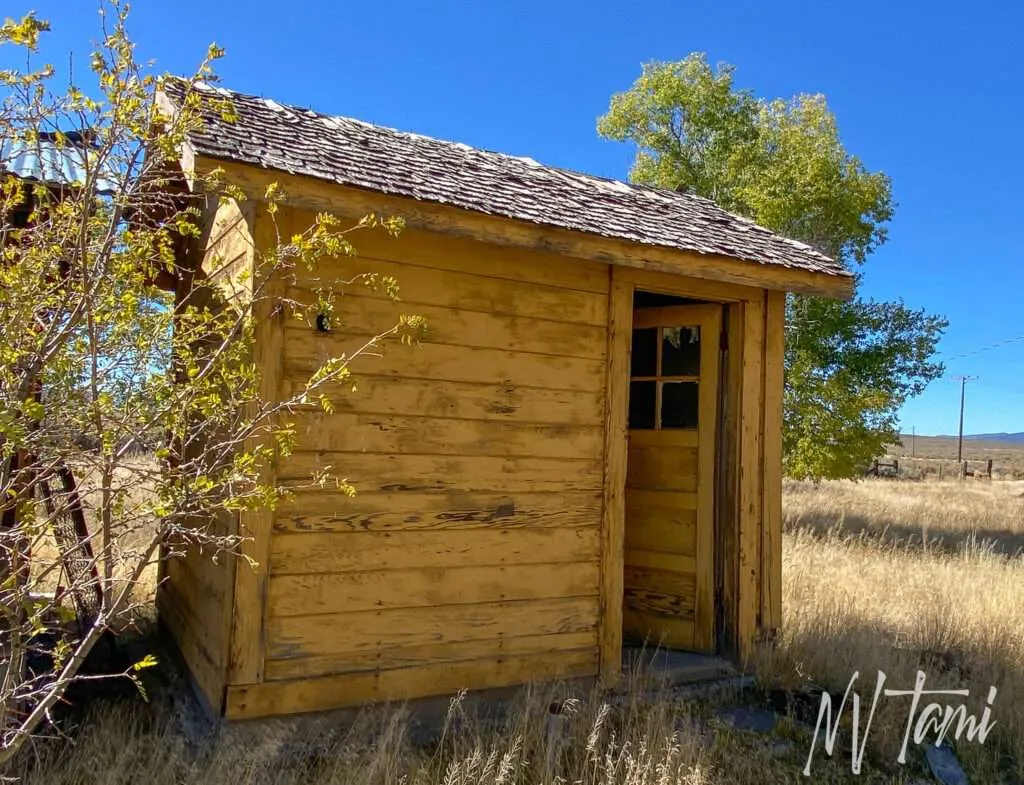 Exterior of a smaller, possibly shed-like structure
Exterior of a smaller, possibly shed-like structure
 Another view of an abandoned house with a distinctive roof
Another view of an abandoned house with a distinctive roof
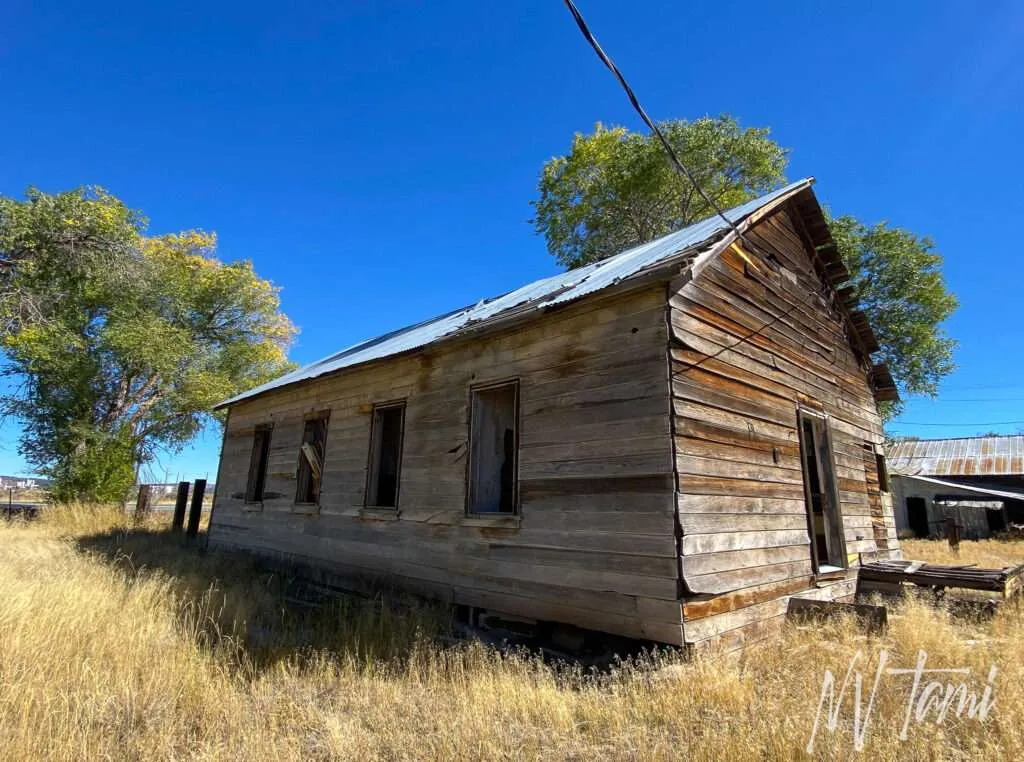 Interior view of an abandoned building, showing remaining items
Interior view of an abandoned building, showing remaining items
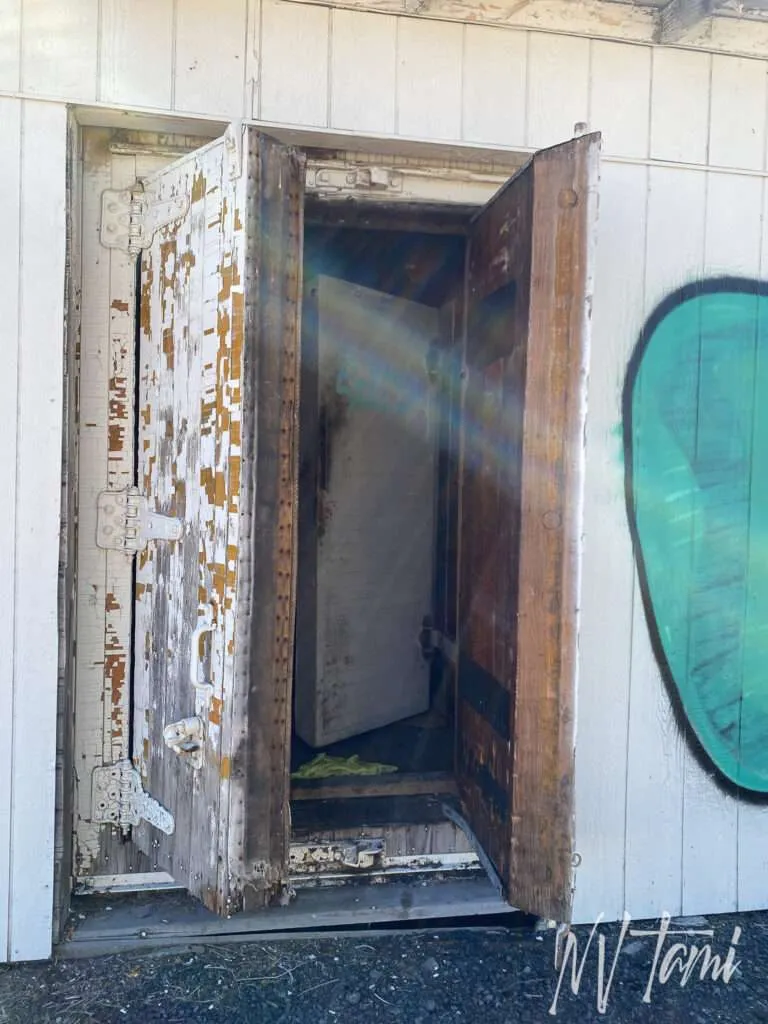 Close-up on abandoned tires and debris
Close-up on abandoned tires and debris
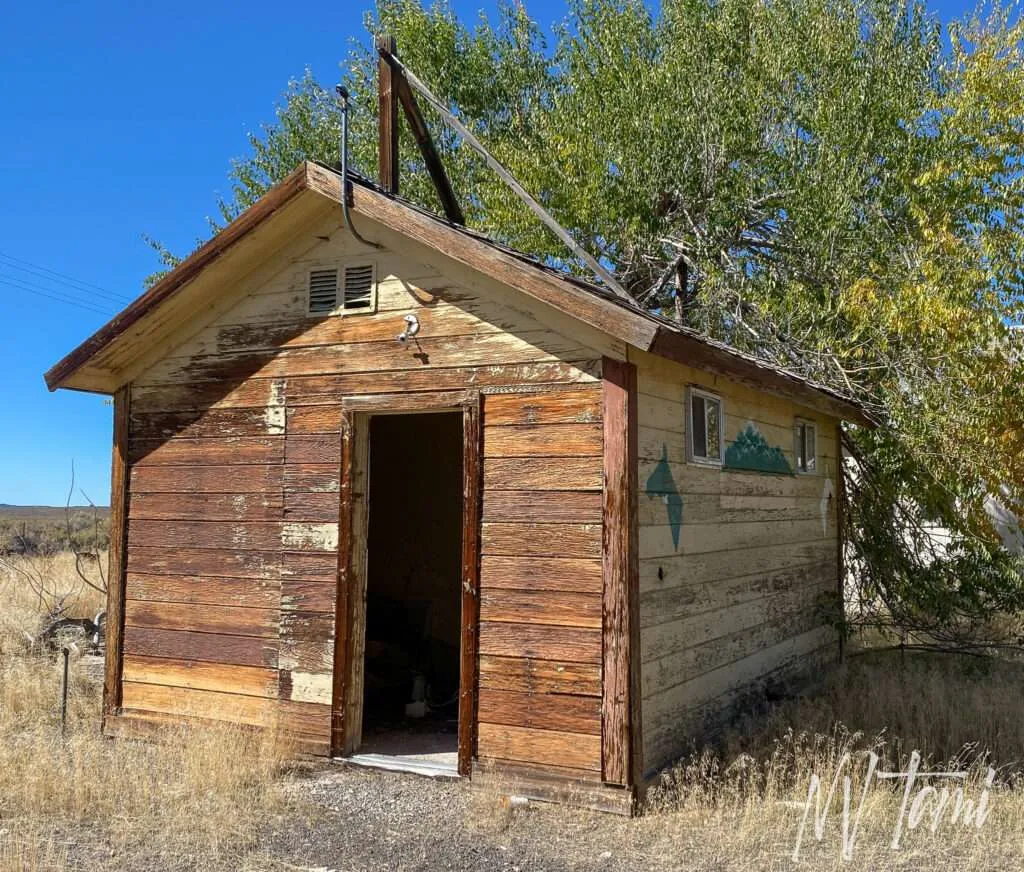 Exterior of a larger, potentially commercial, building in Termo
Exterior of a larger, potentially commercial, building in Termo
Madeline: Railroad Stop Ambitions
Madeline, California, also served as a stop on the N.C.O. line before it was later taken over by the Southern Pacific Railroad. It remained active for a time primarily as a center for livestock shipping. The town’s development was heavily influenced by the Madeline Meadows, Land & Irrigation Company, which attempted to promote the area with rather optimistic advertising. Promotional materials reportedly depicted orange trees thriving along the irrigation ditches – a vision that, having spent time in the region, seems highly unlikely given the harsh winters. This suggests some creative photo editing was employed to entice settlers.
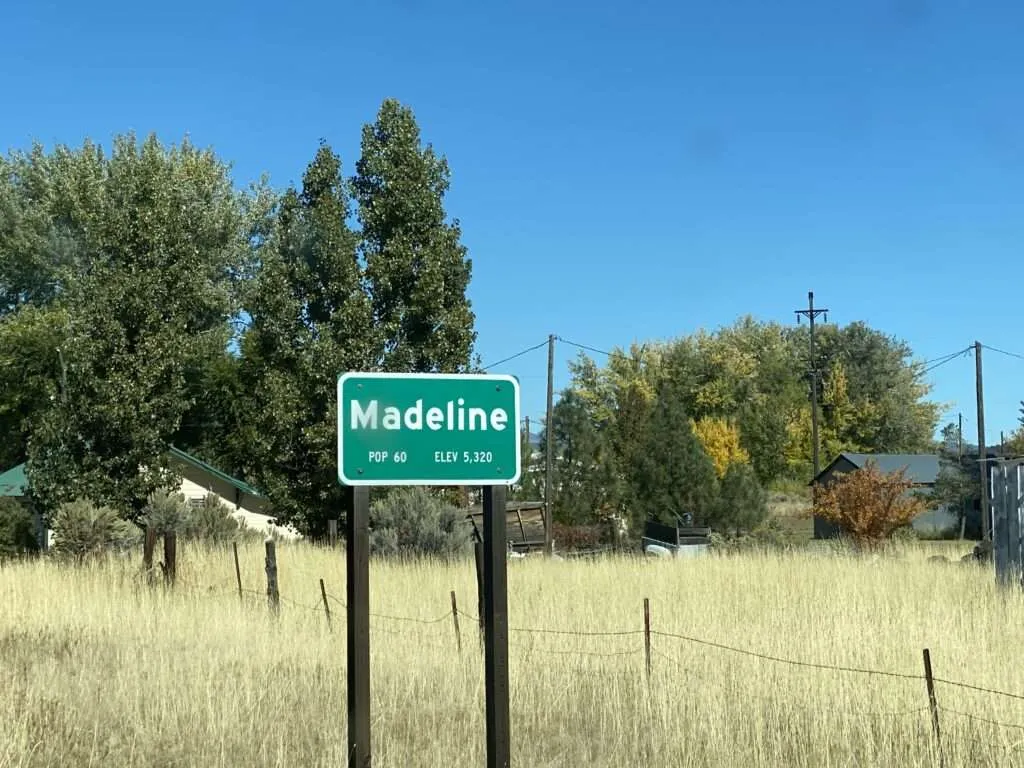 Railroad tracks and buildings in Madeline, California ghost town area
Railroad tracks and buildings in Madeline, California ghost town area
Madeline’s post office history is a tale of fits and starts, opening and closing multiple times between 1875 and 1902. Today, the remains of the railway infrastructure, like the water tower, are perhaps the most prominent reminders of its past life as a railroad stop.
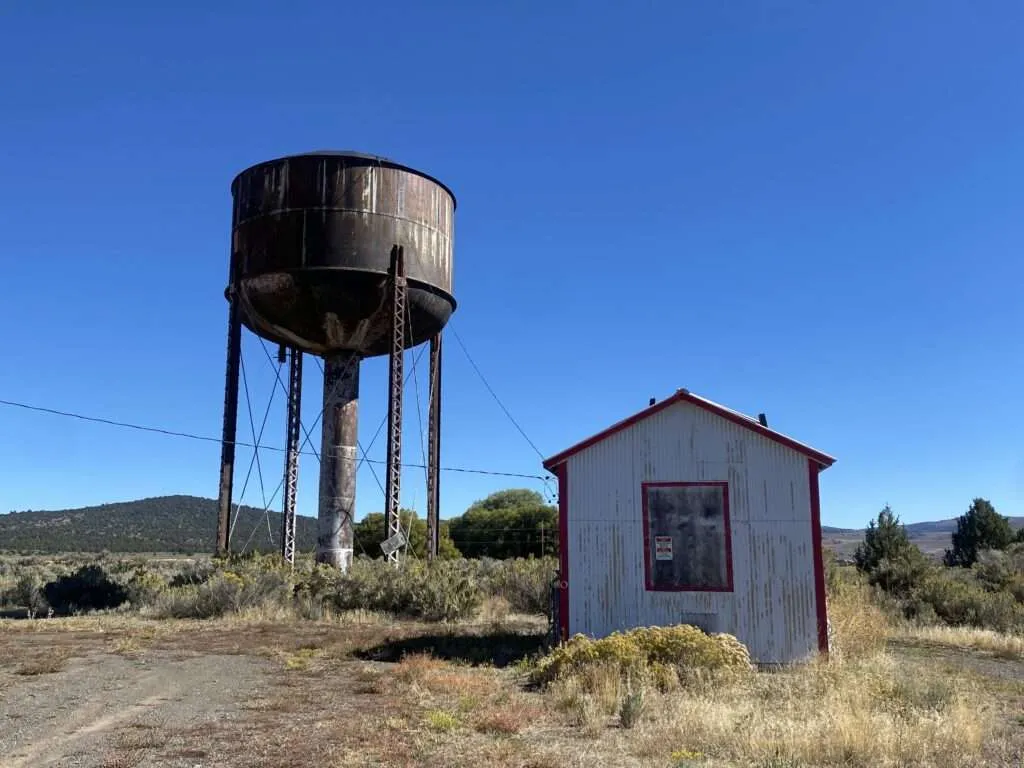 Railroad water tower in Madeline, California ghost town area
Railroad water tower in Madeline, California ghost town area
Lakeview N.C.O. Terminal: The Northern Reach
Venturing further north, the Lakeview, Oregon, N.C.O. terminal represented the northern extent of the railway’s reach. This terminal was vital for both passenger and freight services. Like much of the N.C.O.’s assets, it was purchased by the Southern Pacific Railroad in the 1920s. The depot building itself had a life beyond the railway, eventually being acquired by private owners in 1982.
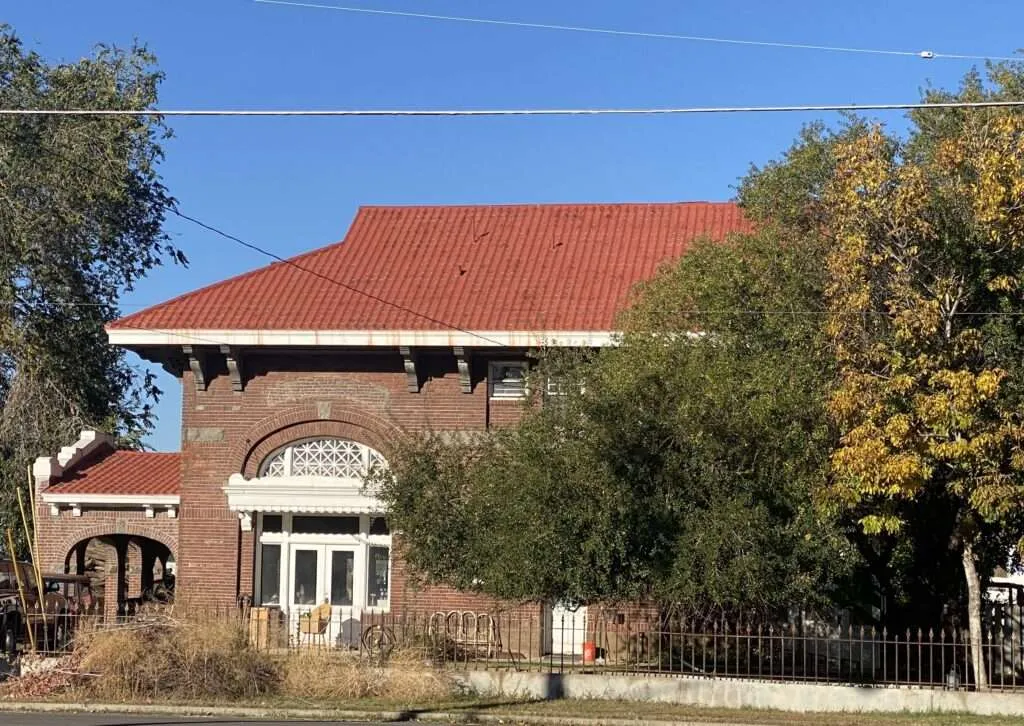 Exterior of the historic Lakeview, Oregon NCO Railway depot building
Exterior of the historic Lakeview, Oregon NCO Railway depot building
Exploring this terminal allows one to appreciate the full scope of the N.C.O.’s ambition, connecting communities from Reno all the way up to Lakeview, Oregon. Historical photographs provide a glimpse of the depot in its prime.
 Historic photo of Lakeview Railroad Depot in 1915
Historic photo of Lakeview Railroad Depot in 1915
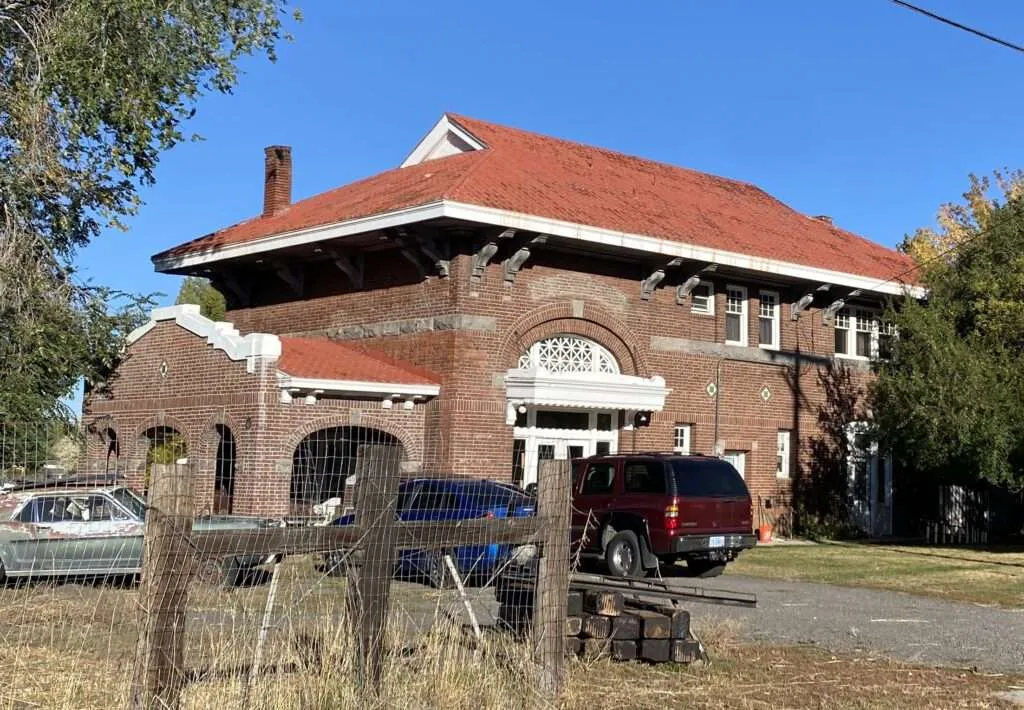 Another view of the Lakeview, Oregon NCO Railway depot
Another view of the Lakeview, Oregon NCO Railway depot
Davis Creek: By the Lake, Then Bypassed
Davis Creek, California, began its existence near the southern edge of Goose Lake with a log cabin in 1869. A post office followed a decade later. In its early days, the town utilized a ferry service across Goose Lake to transport cargo and passengers to Lakeview, Oregon, on the northern shore.
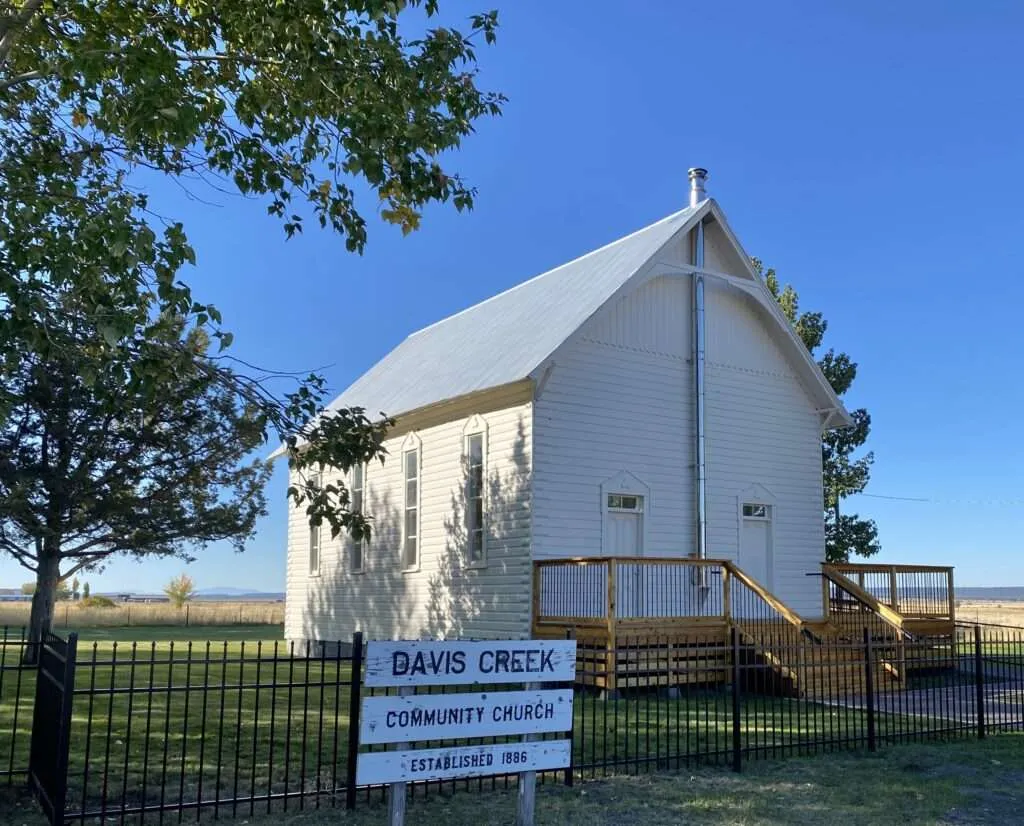 Abandoned building near railroad tracks in Davis Creek, California
Abandoned building near railroad tracks in Davis Creek, California
The arrival of the N.C.O. at Davis Creek in 1911 marked a significant change, leading to the discontinuation of the ferry service as rail transport became dominant. However, like many towns built around older routes, Davis Creek faced a new challenge in the early 1960s when Highway 395 was realigned, bypassing the town’s main business section. This shift in transportation routes led to a decline, leaving behind remnants of its history by the now-receded lake.
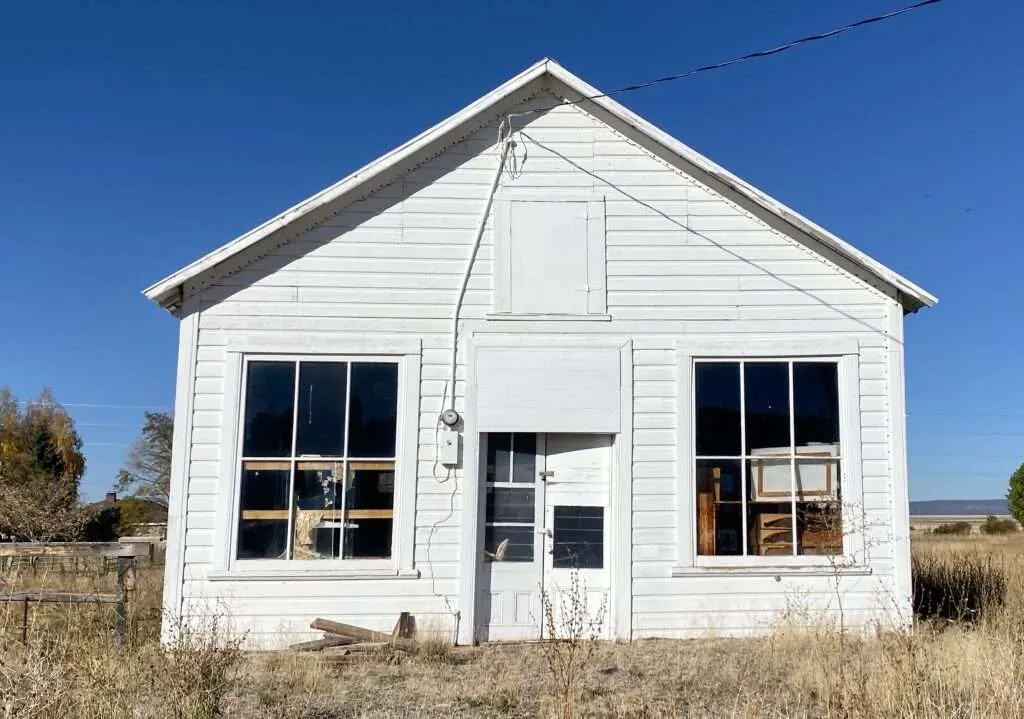 View of old railroad infrastructure in Davis Creek
View of old railroad infrastructure in Davis Creek
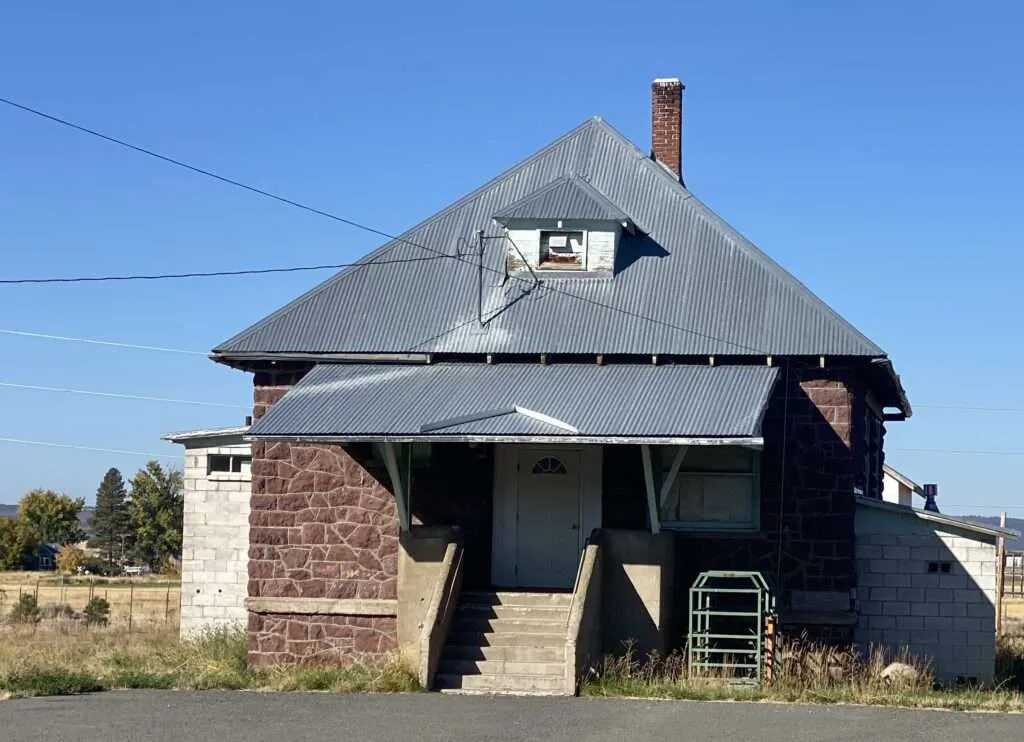 Another view of abandoned structures in Davis Creek
Another view of abandoned structures in Davis Creek
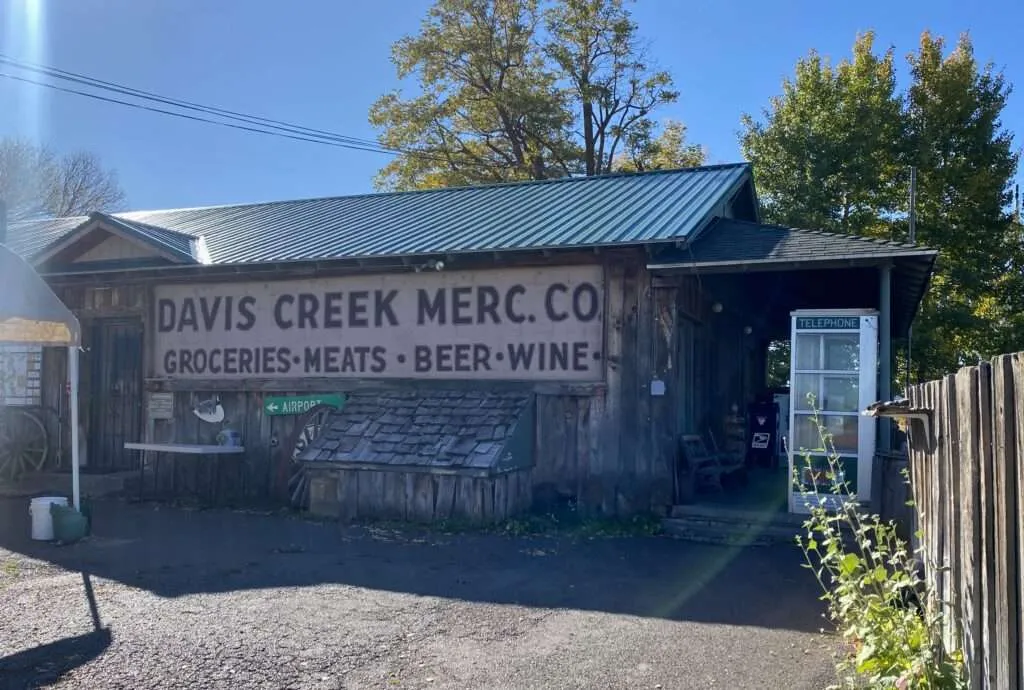 Empty street or road in Davis Creek with abandoned properties
Empty street or road in Davis Creek with abandoned properties
Chimney Rock: A Unique Pioneer Home
Chimney Rock, California, is notable for a truly unique piece of pioneer history. Thomas Denson, one of the first non-native settlers in the Pit River Valley, was a master craftsman who built his log cabin in 1871 around a natural sandstone pyramid. Ingeniously, he carved a chimney directly into the rock formation itself. This cabin was reportedly the second structure built in the Pit River Valley.
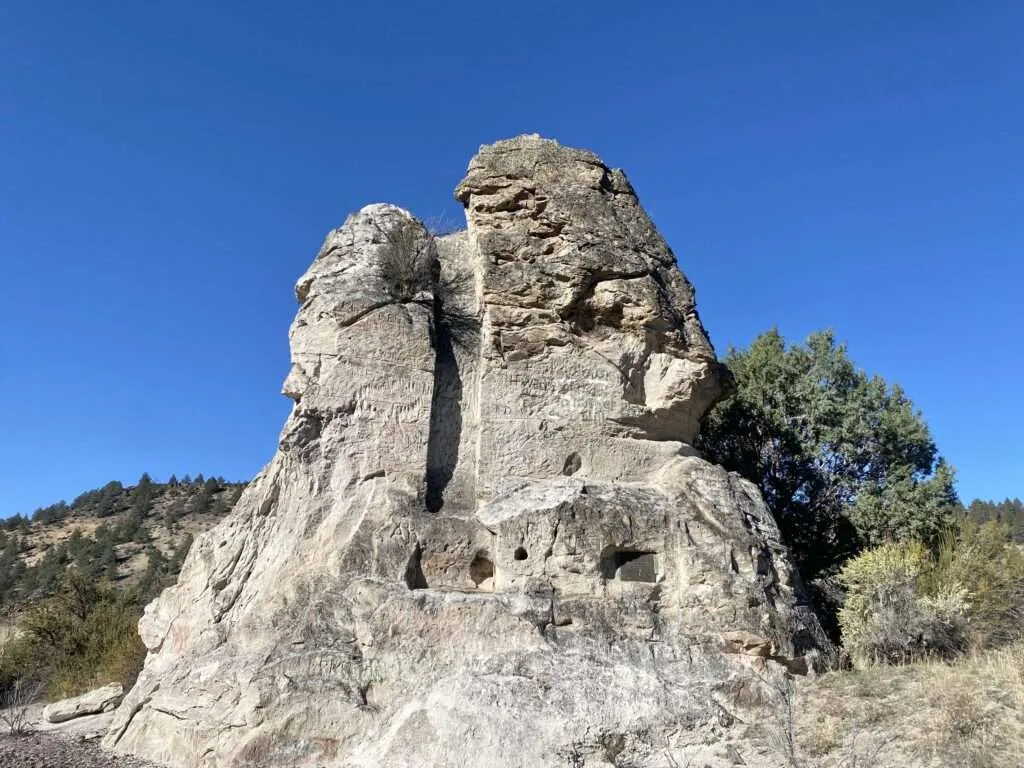 The distinctive Chimney Rock formation with log cabin remnants
The distinctive Chimney Rock formation with log cabin remnants
The site of Chimney Rock stands as a testament to the resourcefulness and unique building methods employed by early settlers adapting to the landscape. It’s a fascinating historical site to visit, showcasing a blend of natural geology and human ingenuity.
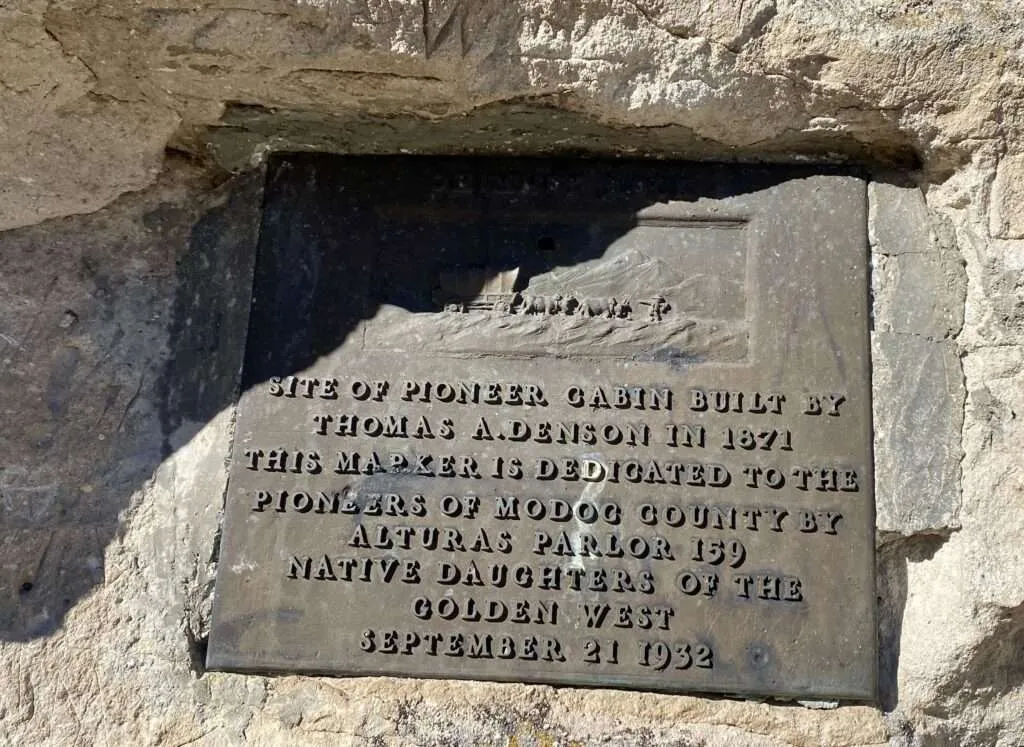 Close-up view of the rock and log structure
Close-up view of the rock and log structure
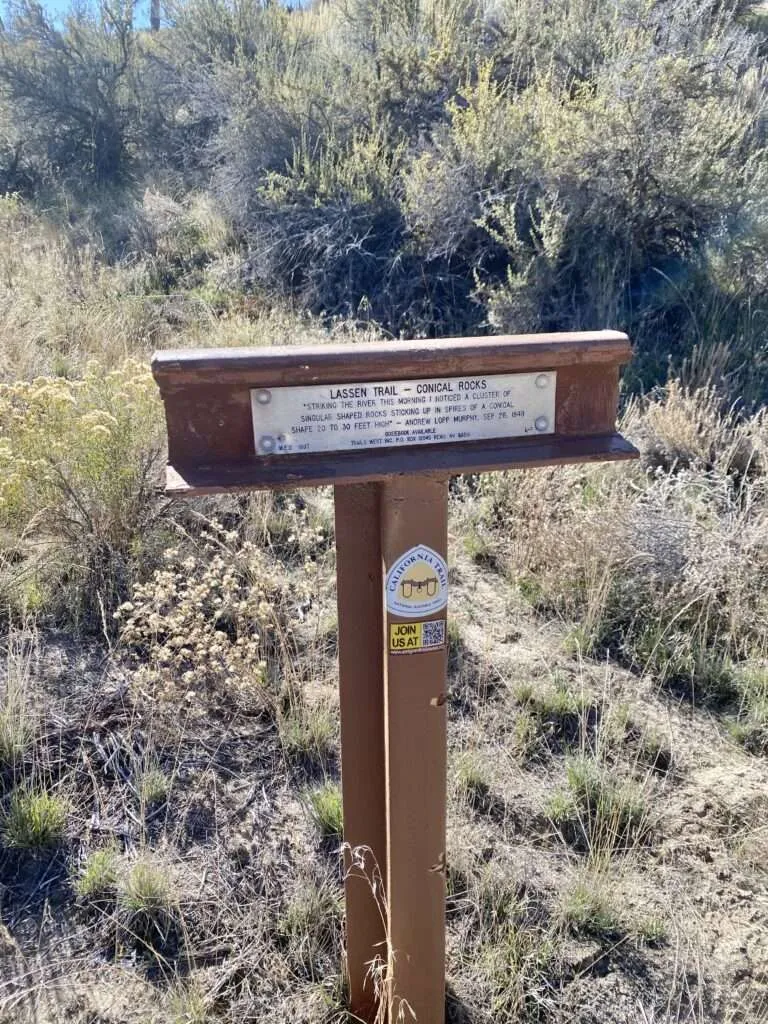 Vertical shot highlighting the height of the rock formation
Vertical shot highlighting the height of the rock formation
Alturas: A Railway Headquarters
Alturas, California, gained significance in the N.C.O. story when the railway relocated its headquarters here in 1918, following the sale of the southern portion of the line (the part running closer to Reno) to the Western Pacific Railroad. To house their operations, they constructed a large office building in 1917 in the Mission Revival style.
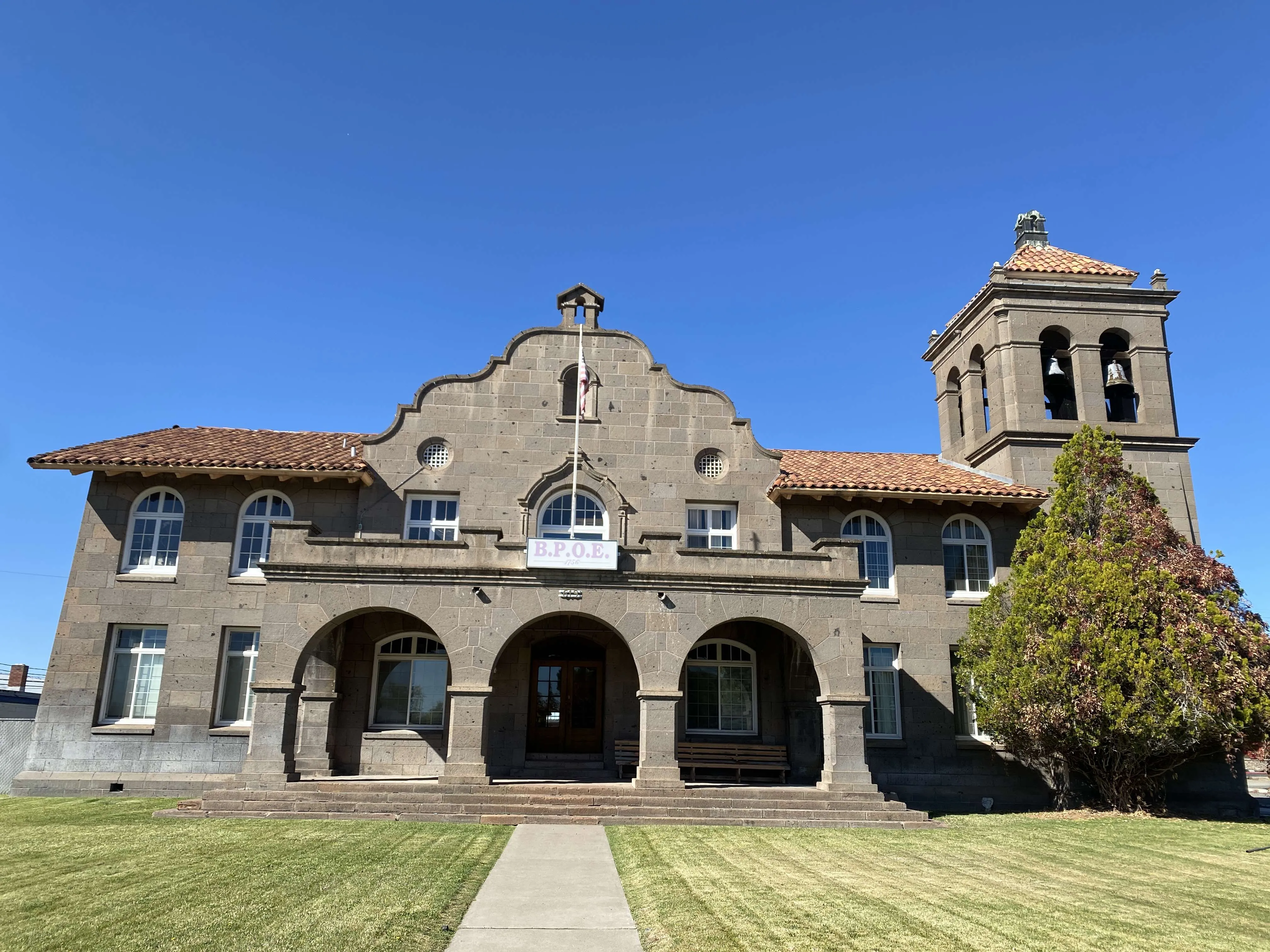 Mission Revival style building in Alturas, California, former NCO headquarters
Mission Revival style building in Alturas, California, former NCO headquarters
A quirky detail about the impressive tower on the building is that the N.C.O. lacked the funds for five real bells; only one was genuine, with the others being wooden replicas. The town also features an N.C.O. depot, originally built in 1908 as a “whistle stop.” This depot was moved stone by stone to its current location in 1915 and is now home to the Alturas Garden Club, preserving a piece of the railway’s operational history.
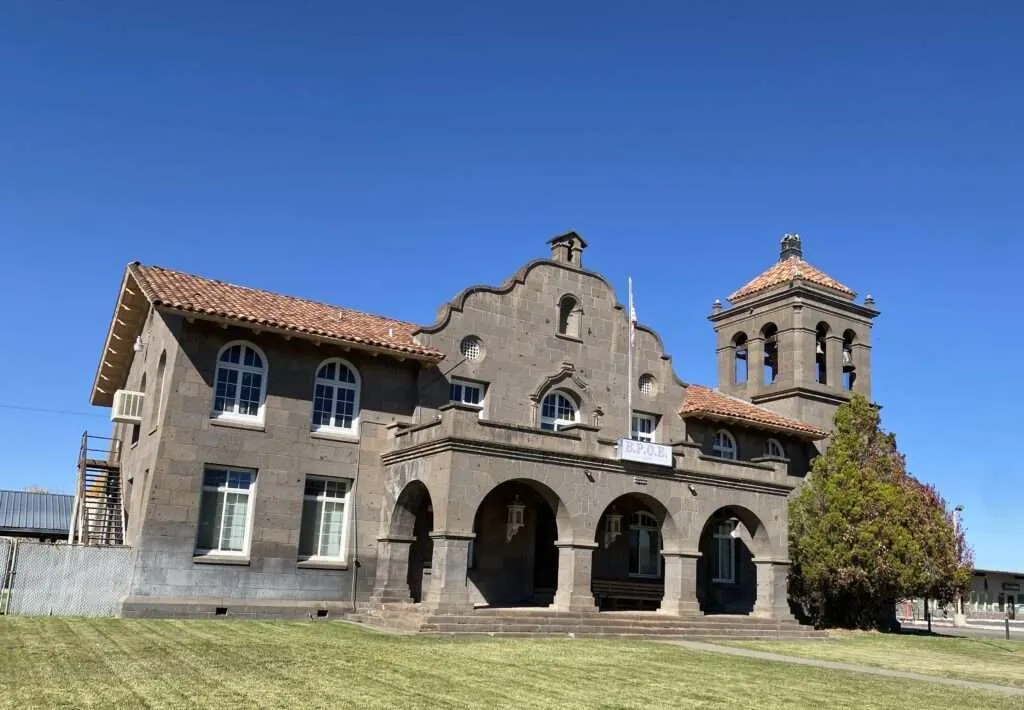 Closer view of the NCO headquarters building facade
Closer view of the NCO headquarters building facade
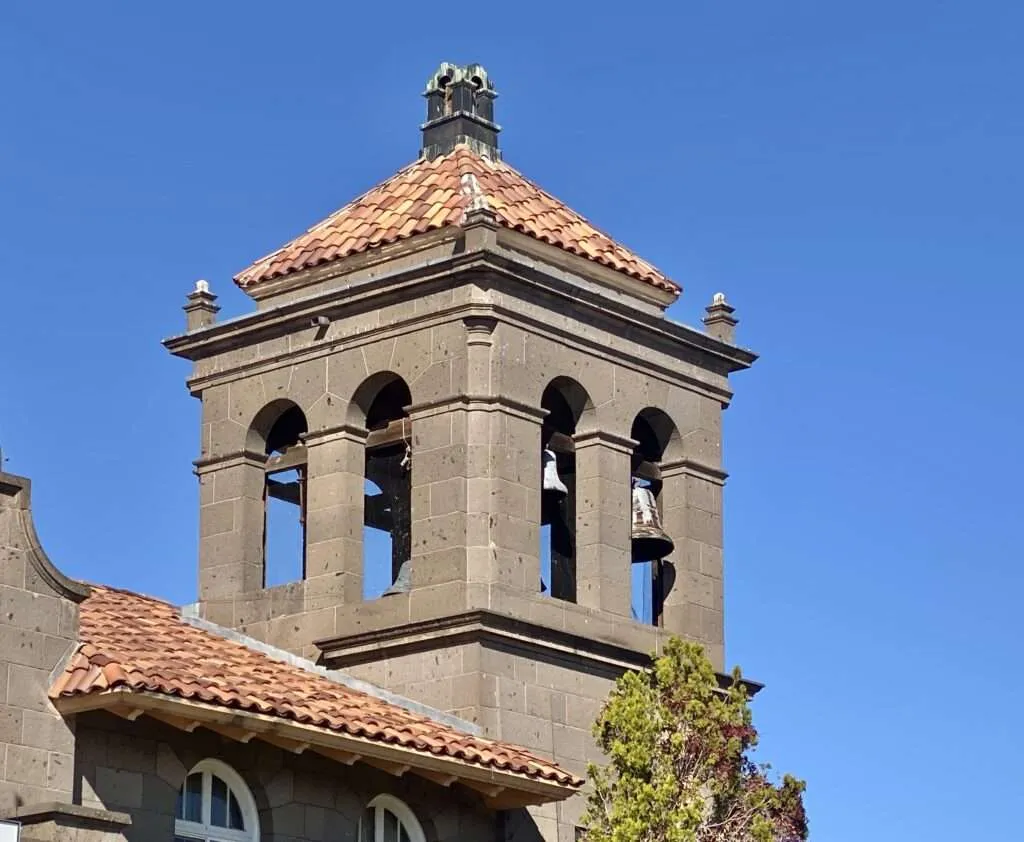 Detail of the tower on the NCO headquarters building
Detail of the tower on the NCO headquarters building
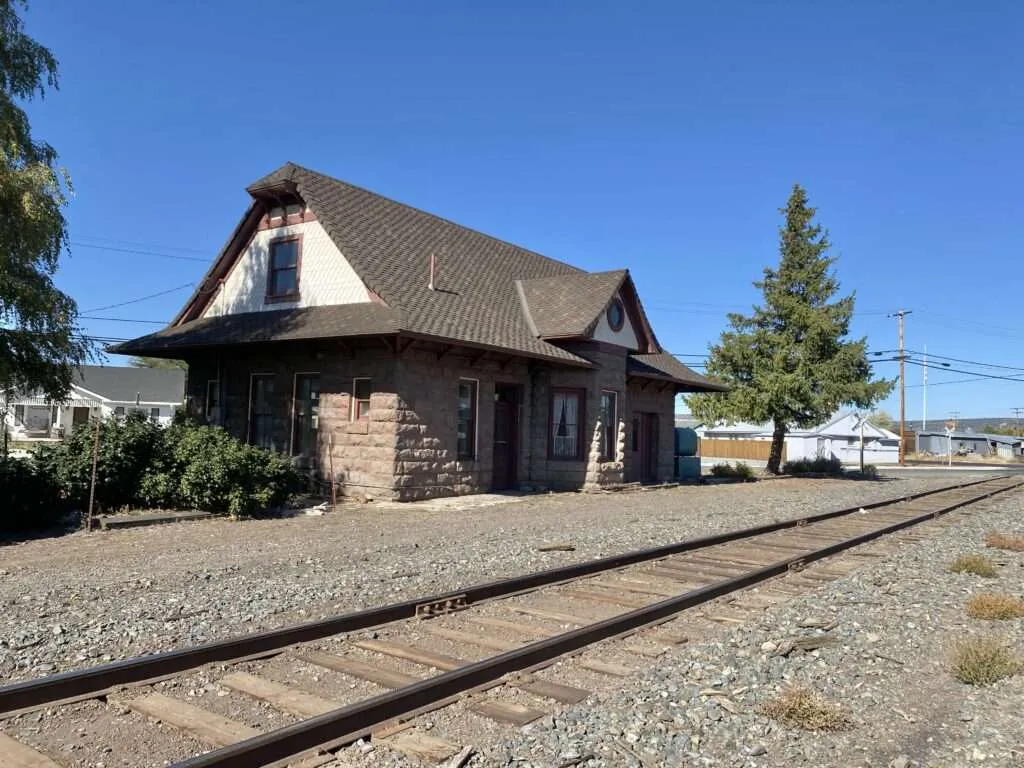 Exterior view of the Alturas NCO railway depot building
Exterior view of the Alturas NCO railway depot building
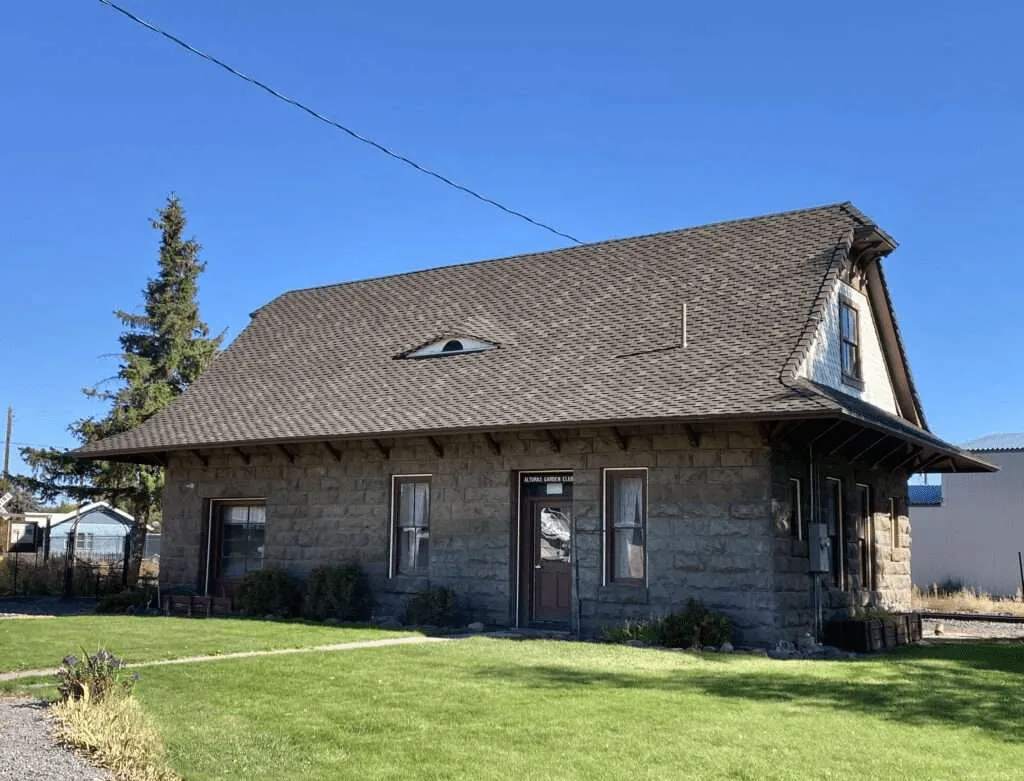 Historic photo of the Alturas NCO depot
Historic photo of the Alturas NCO depot
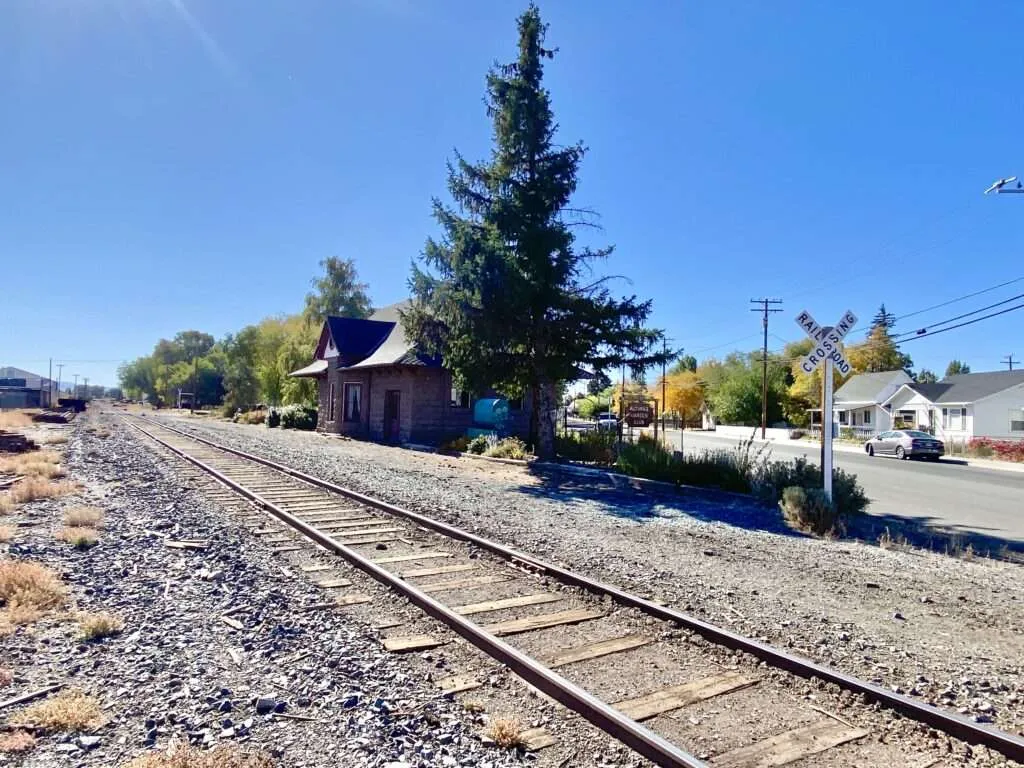 Another angle of the Alturas NCO railway depot
Another angle of the Alturas NCO railway depot
The “Scary Ranch House”
While technically not a ghost town, an abandoned ranch house located between Klamath Falls and Reno (dubbed the “Scary Ranch House” by my husband) is a memorable, if mysterious, stop. Despite lacking specific historical information about this particular property, its desolate beauty captured my attention on a previous trip and again on this one. Abandoned ranch houses are frequent, poignant sights in the rural West, each holding unknown stories within their crumbling walls.
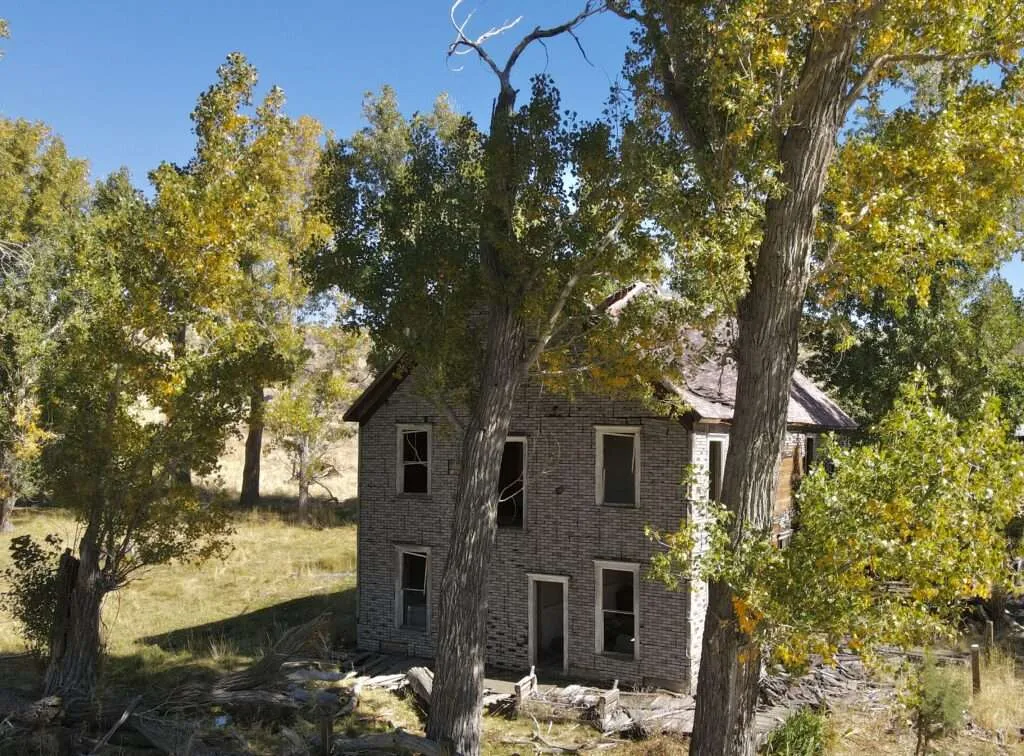 Abandoned ranch house in Modoc County, California
Abandoned ranch house in Modoc County, California
These isolated structures evoke a sense of solitude and curiosity, inviting speculation about the lives lived there before the land was left to reclaim its own.
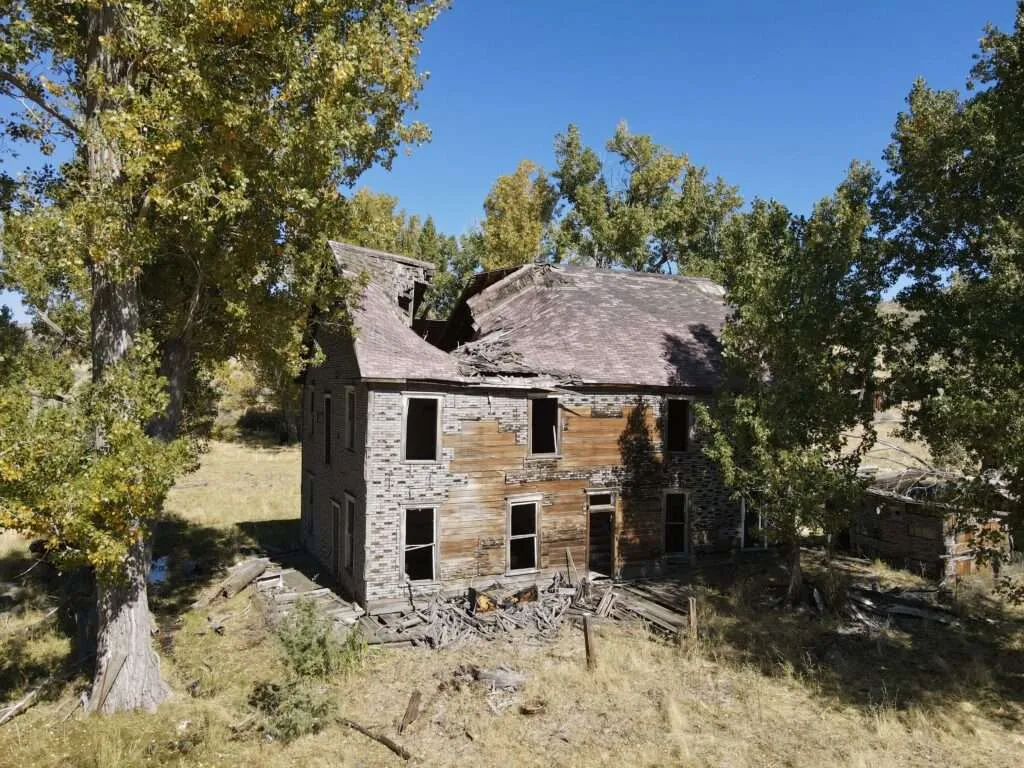 Another aerial view of the abandoned ranch house
Another aerial view of the abandoned ranch house
Susanville: A County Seat’s History
Susanville, California, holds historical significance beyond just being a stop on a railway branch. It’s home to Roop’s Fort, built by Isaac Roop as a fort and trading post in 1854. This was the very first non-native structure erected in what is now Lassen County. The area’s early history was marked by border disputes; in 1861, Susanville and its surroundings were declared part of Roop County, Nevada. This led to the brief and almost comical “Sagebrush War” in 1863, a four-hour conflict with only two injuries, with Roop’s Fort serving as the encampment for the Nevadan side.
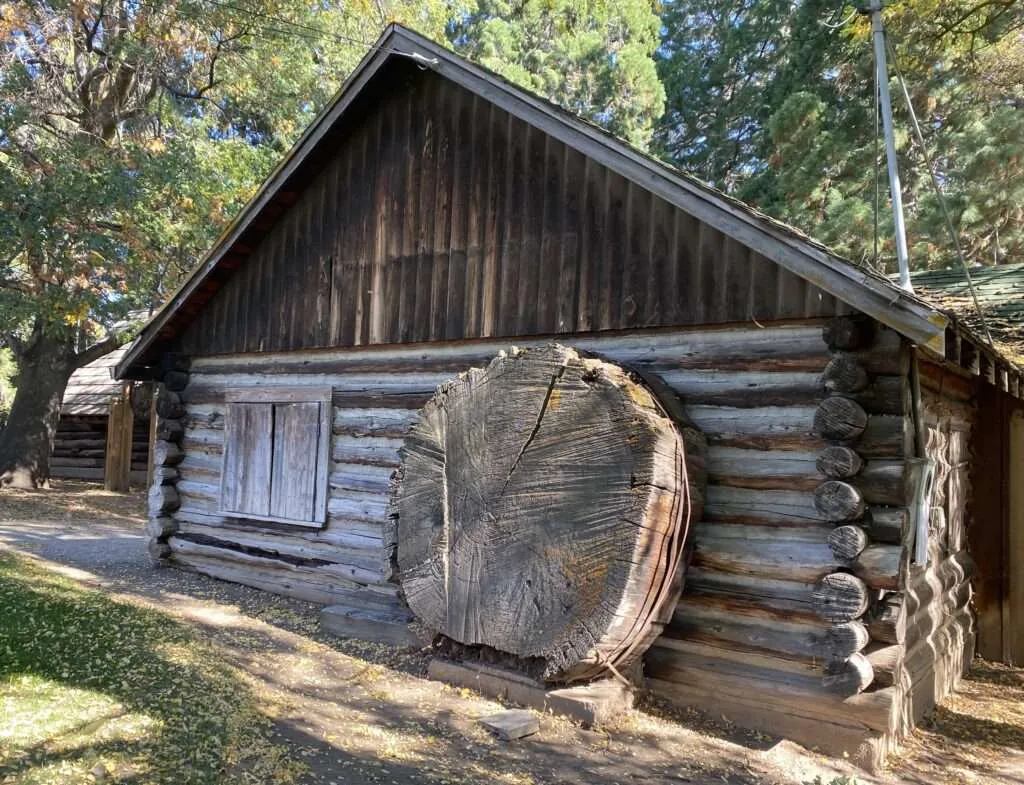 Roop’s Fort in Susanville, California
Roop’s Fort in Susanville, California
While not a ghost town itself, Susanville is surrounded by the history of the region and features notable historic buildings. The Fernley & Lassen Railroad depot, built in 1927, replaced an earlier structure and served passengers until 1979. This building was famously saved from being intentionally burned for fire department training by local protests in 1987, highlighting the community’s appreciation for its history.
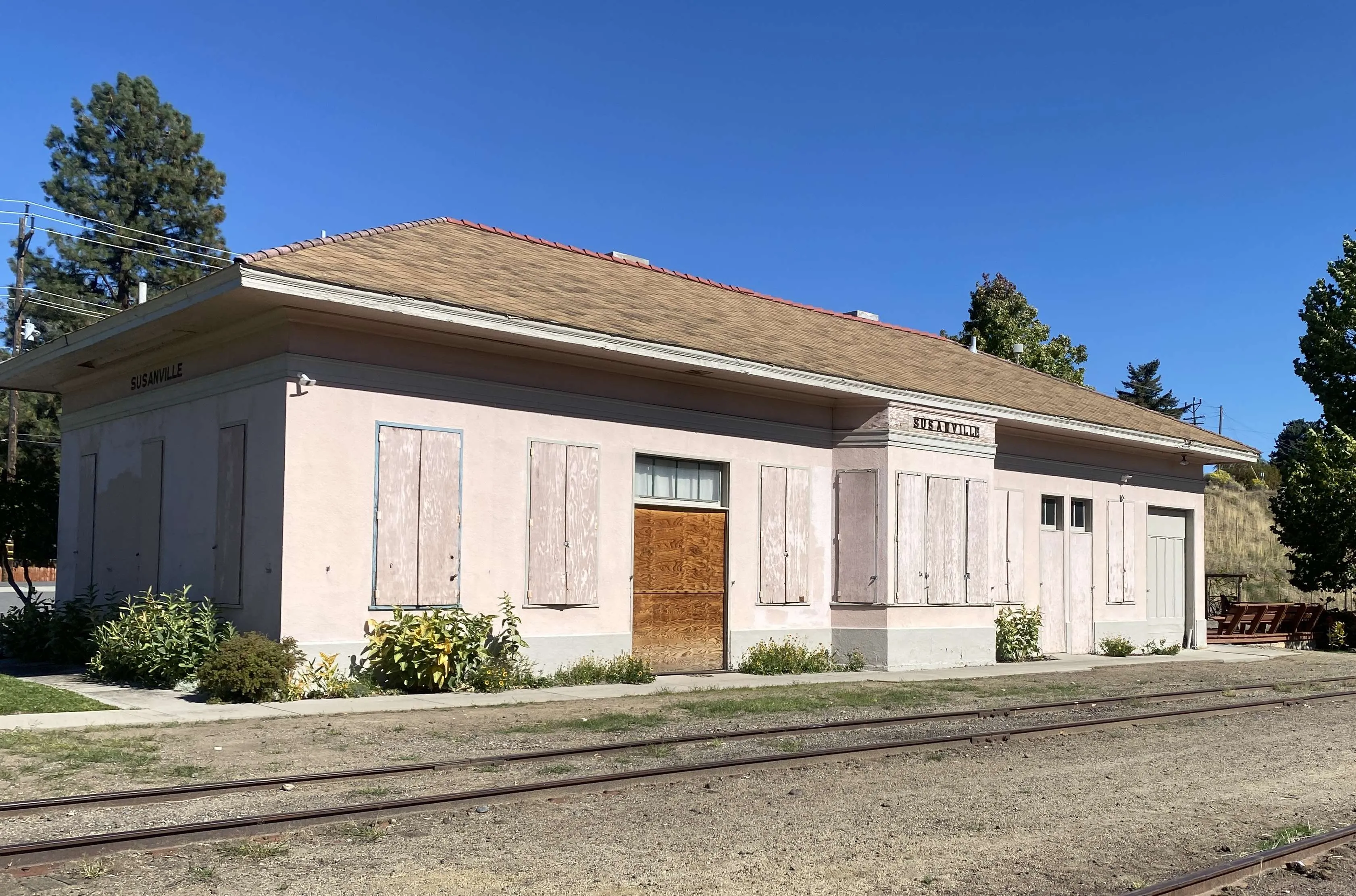 Fernley & Lassen Railroad depot building in Susanville, California
Fernley & Lassen Railroad depot building in Susanville, California
Other historic structures in Susanville include the Lassen County courthouse, which opened in 1917, and the Lassen County Jail, built in 1911 and condemned in 1971. Exploring these buildings provides context for the governmental and social history of the area alongside the more isolated ghost towns.
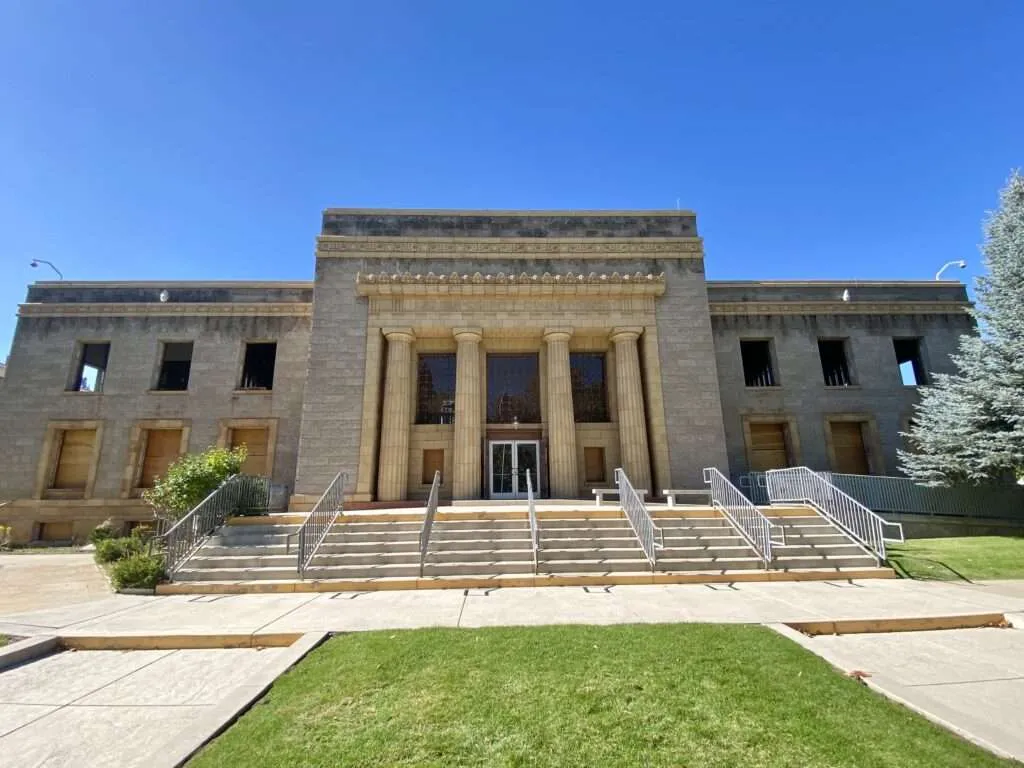 Lassen County courthouse in Susanville
Lassen County courthouse in Susanville
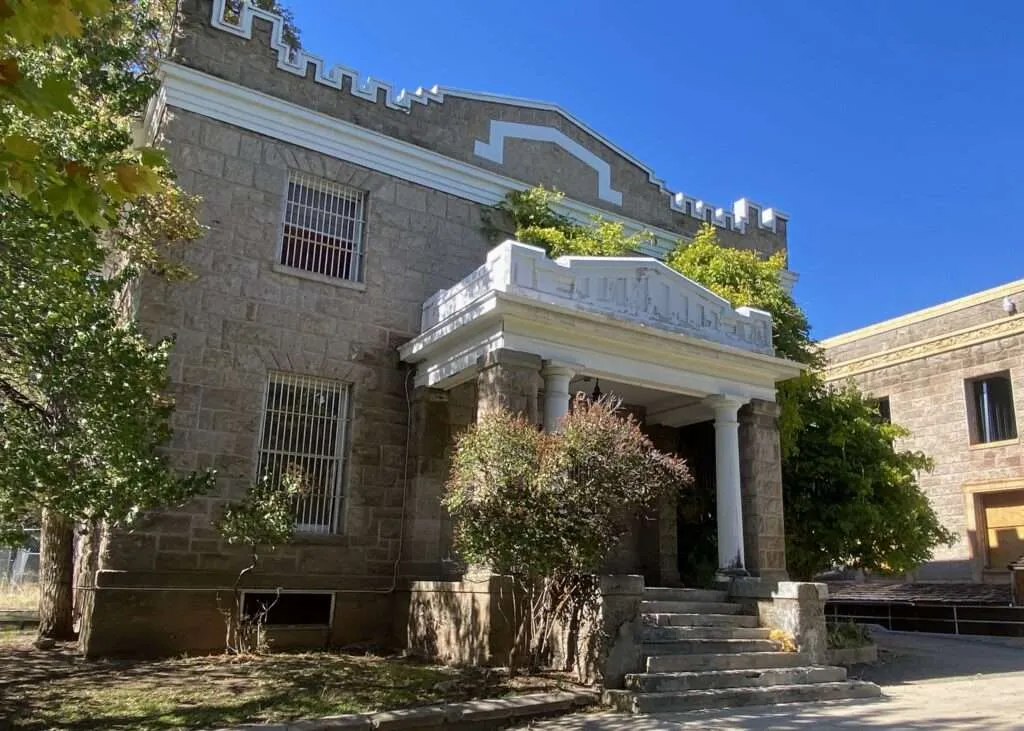 Lassen County Jail building in Susanville
Lassen County Jail building in Susanville
Like the “Scary Ranch House,” Susanville also has its share of visually striking abandoned properties, like an old ranch house I encountered, whose history remains unknown but adds to the area’s character.
 Abandoned ranch house near Susanville
Abandoned ranch house near Susanville
Janesville: Fort, Town, and Wigwams
Janesville, California, shares historical ties with Susanville and features its own unique historical sites. During the Pauite War in 1859, settlers constructed Fort Janesville, a loopholed stockade with a bastion, as a defensive measure. Although an attack never occurred, the fort stands as a reminder of the tensions of the era.
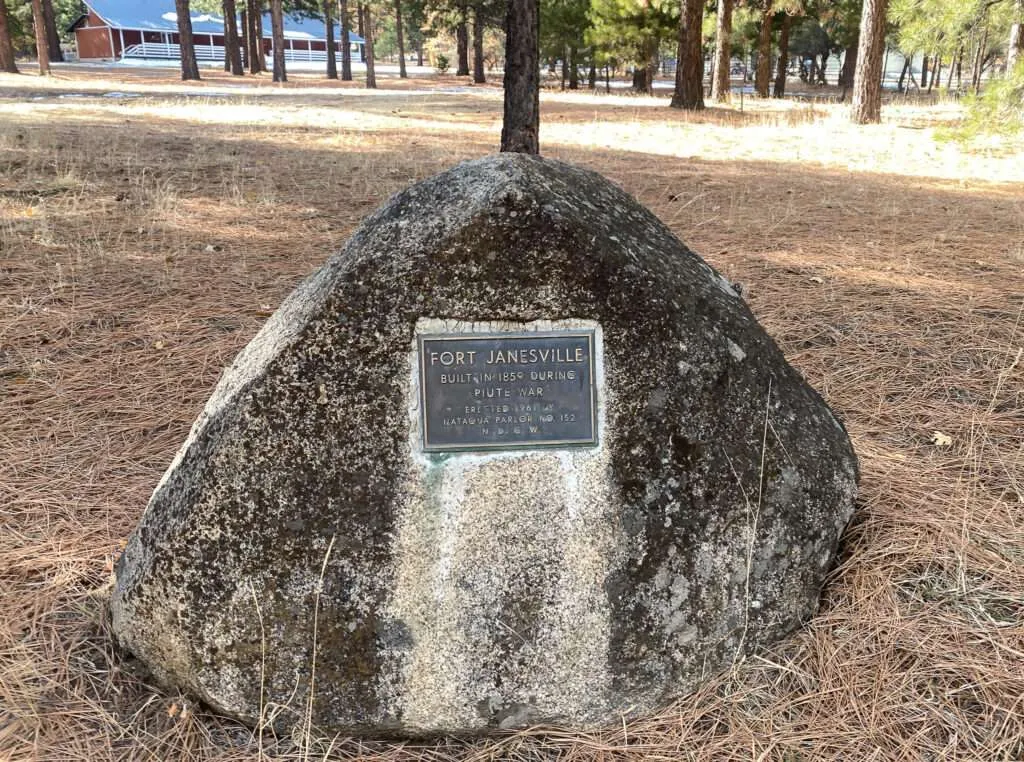 Reconstructed Fort Janesville stockade
Reconstructed Fort Janesville stockade
Janesville itself narrowly missed becoming the Lassen County Seat, losing to Susanville by just one vote, a historical near-miss that shaped its development. Perhaps one of the most unique historical remnants near Janesville is an old Wigwam roadside motel. I learned about it from a book, and thanks to some real-time help from Nevada Expeditions, I was able to find the correct location (it’s sometimes listed as Milford).
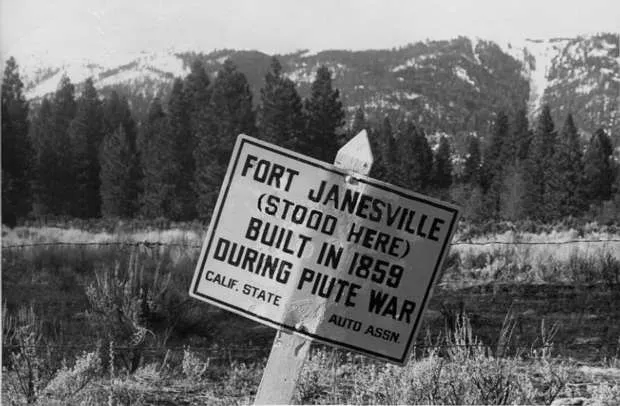 Sign for Fort Janesville
Sign for Fort Janesville
The Janesville Wigwams: A Roadside Relic
The Wigwam Motor Inn near Janesville is a fantastic piece of mid-20th-century roadside Americana. These structures, shaped like teepees, were a unique architectural trend for motels. Speaking with the current owner provided fascinating, albeit sobering, insight. He mentioned his insurance was canceled, which is why visitors can’t walk around the property, but he was happy to share its history. The motel was a popular stop on Highway 395 before the road was realigned. Each teepee structure functioned as a suite with a bedroom, bathroom, and small kitchen.
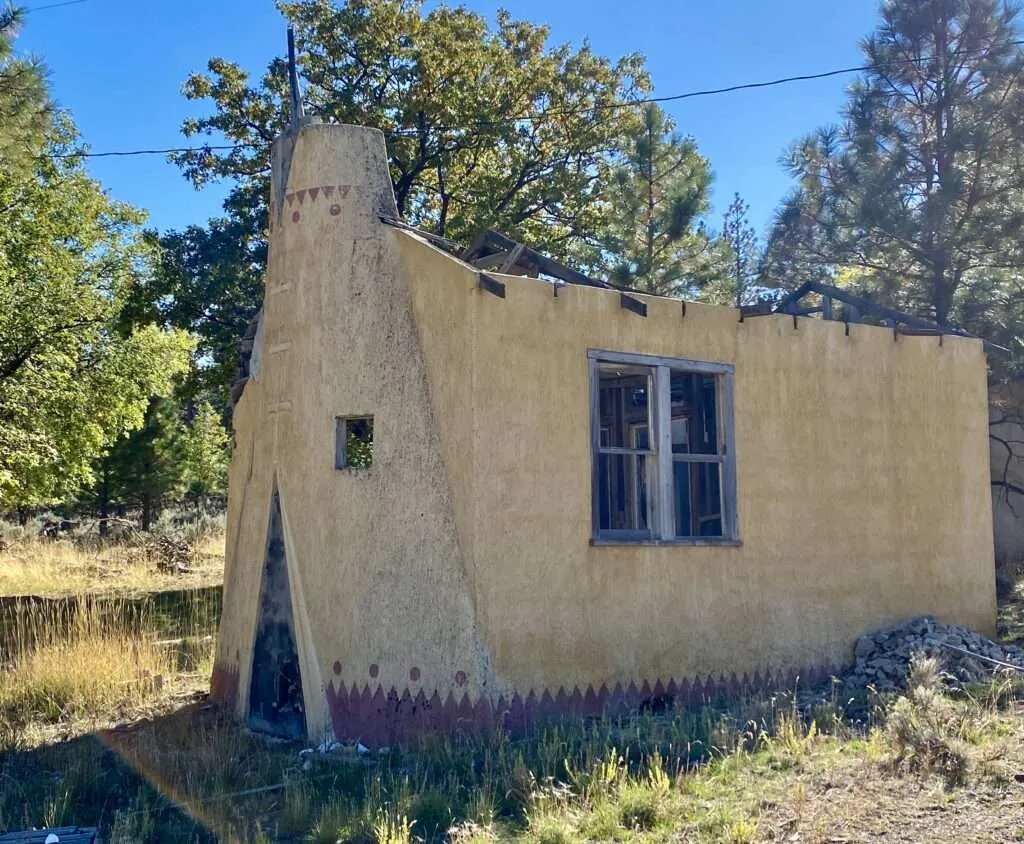 Several wigwam-shaped motel units in Janesville, California
Several wigwam-shaped motel units in Janesville, California
Disturbingly, the owner recounted that the original proprietor was racist and chose to close the motel entirely when laws required him to accommodate “blacks and Jews.” This adds a challenging and important layer to the history of this seemingly whimsical roadside attraction, reminding us that even lighthearted architecture can carry heavy historical context. Seeing these unique structures from the road is a memorable part of exploring the area’s history.
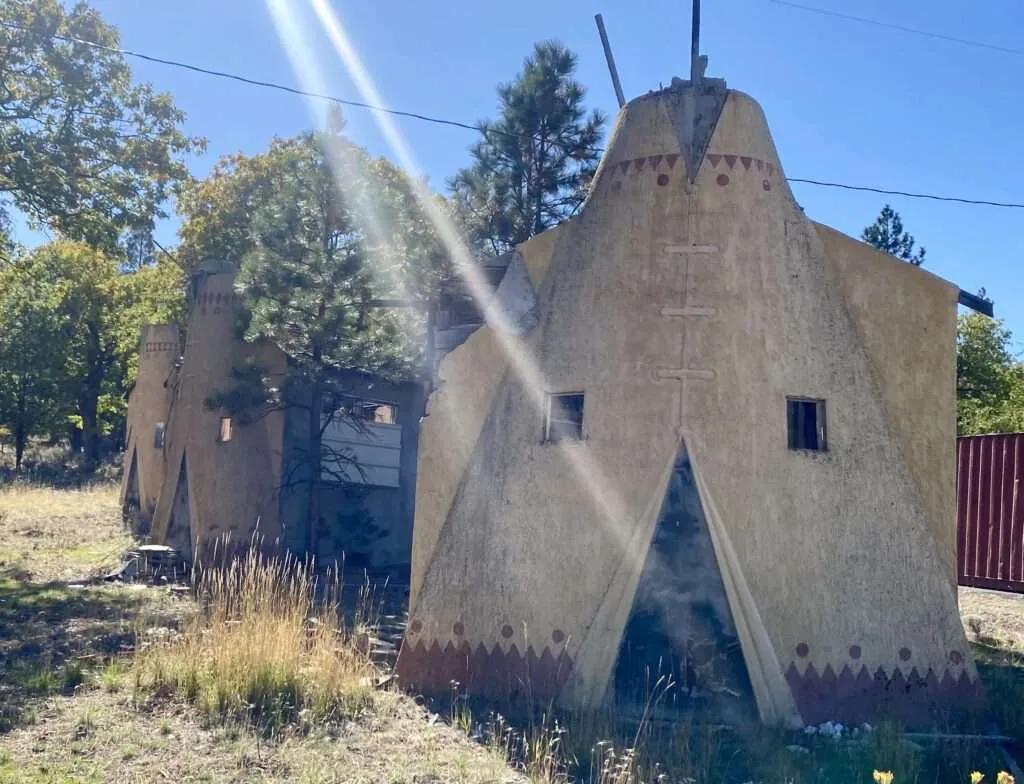 Front view of one of the wigwam motel units
Front view of one of the wigwam motel units
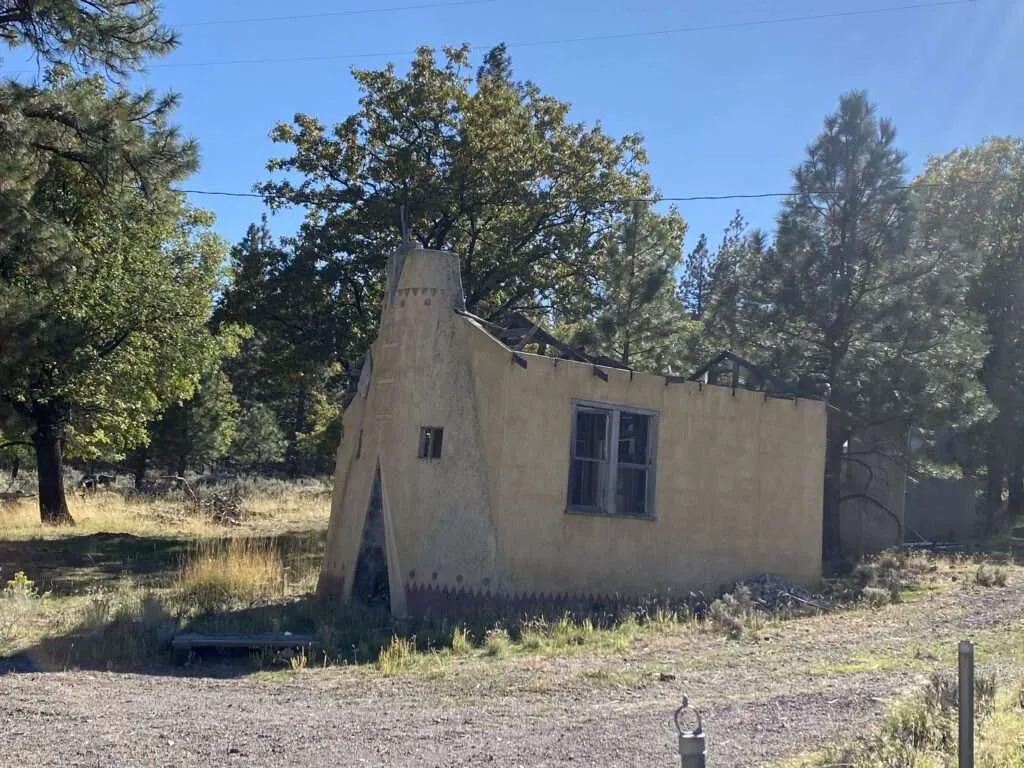 Row of wigwam motel units
Row of wigwam motel units
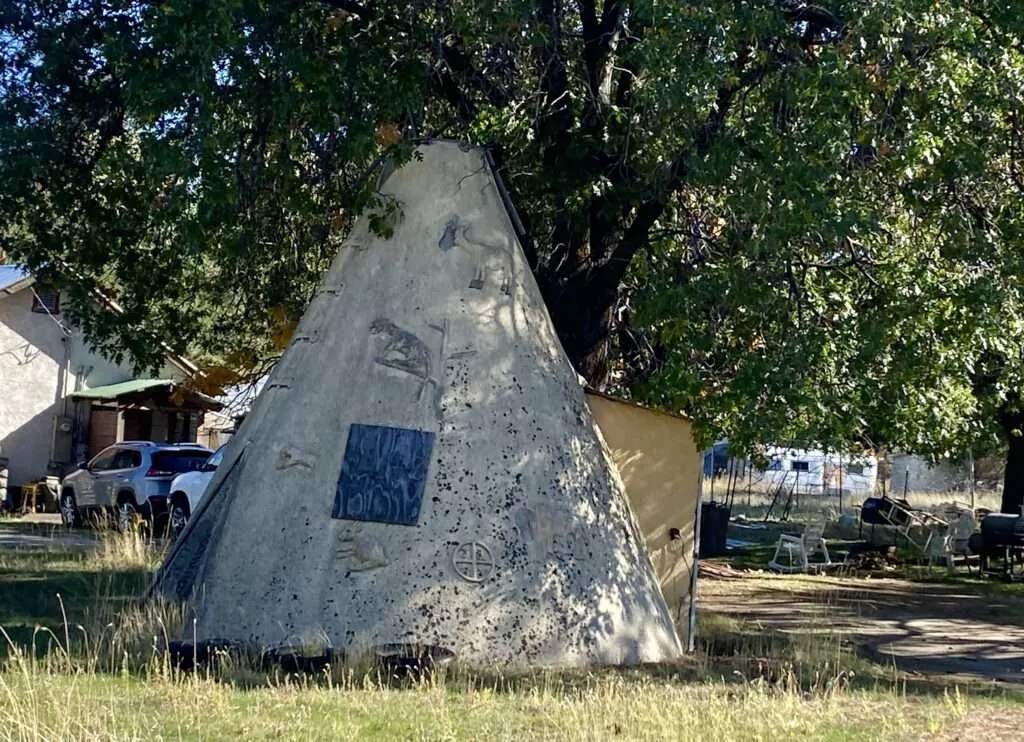 View looking down the line of wigwam units
View looking down the line of wigwam units
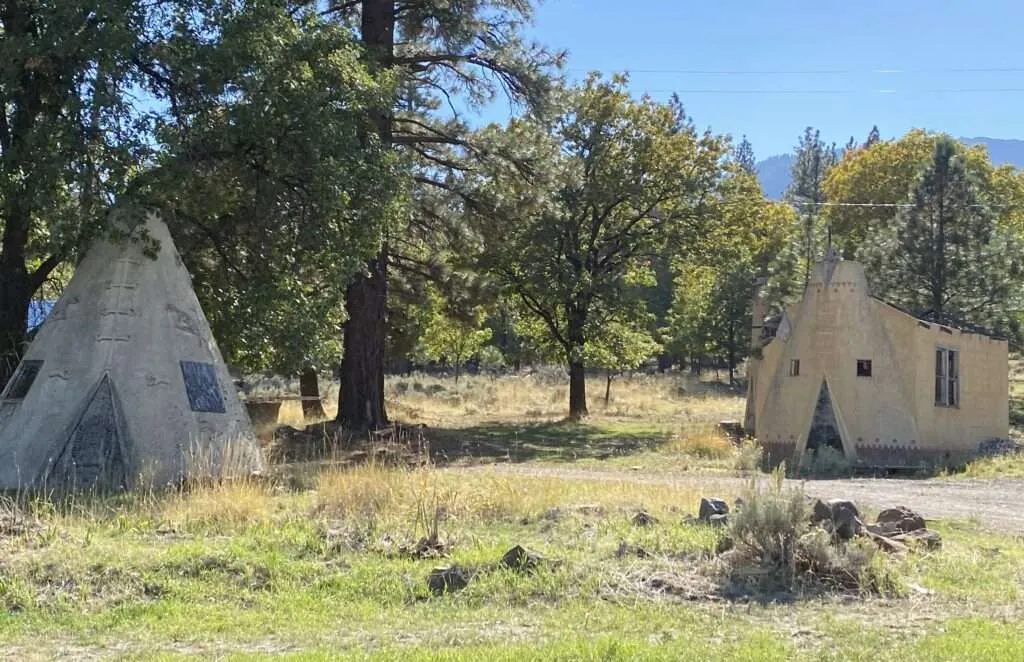 Exterior shot of a wigwam unit from the road
Exterior shot of a wigwam unit from the road
Doyle: A Church and a Community
Doyle, California, is another small community with historical roots in the region. I vividly remember seeing the charming Doyle Church on my first drive from Oregon to Nevada, and I was relieved and happy to see that this beautiful structure survived a recent local wildfire. The church, originally named St. Mary’s Chapel Constantia, was added around 1898 by Henry Butters to the Albert E. Ross ranch in Long Valley. Catholic services were held there until 1920 whenever a priest was available. In 1994, the church was relocated to its current site in Doyle, fittingly next to the cemetery.
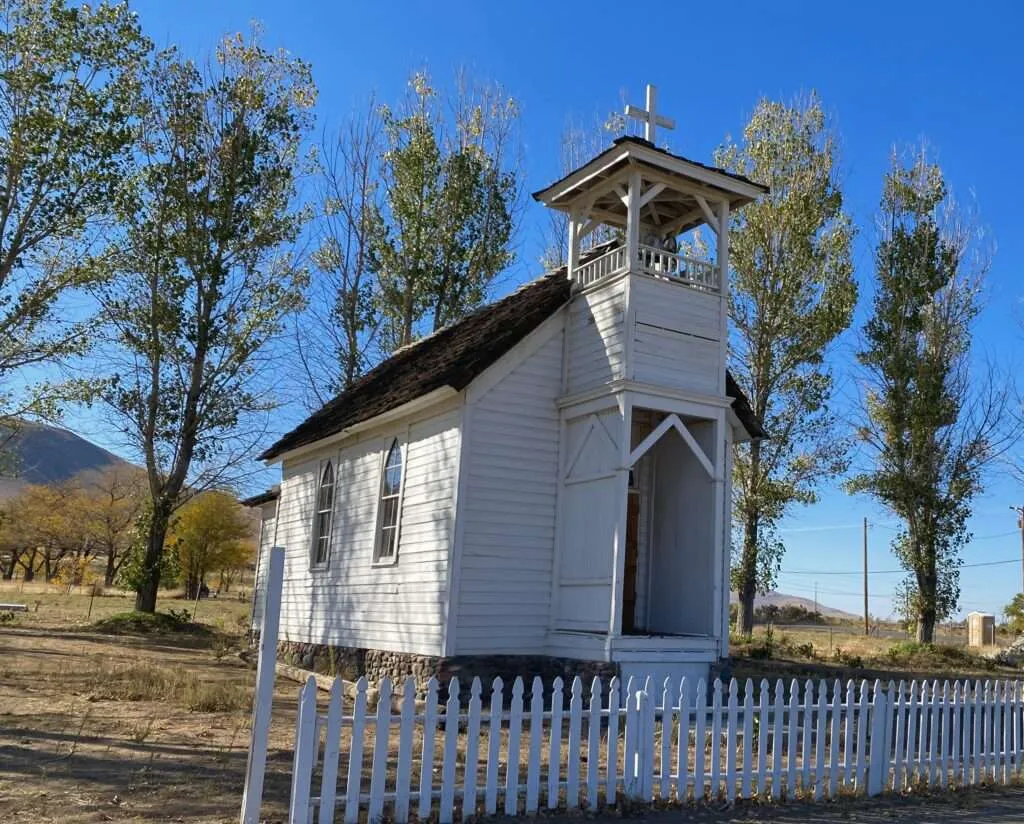 Historic Constantia Church, relocated to Doyle, California
Historic Constantia Church, relocated to Doyle, California
Doyle itself was settled in the 1870s and was named in honor of Oscar Doyle, who generously donated the land for the townsite. While not a ghost town in the same sense as some others, it represents the enduring, albeit quiet, presence of settlements established during the same historical period.
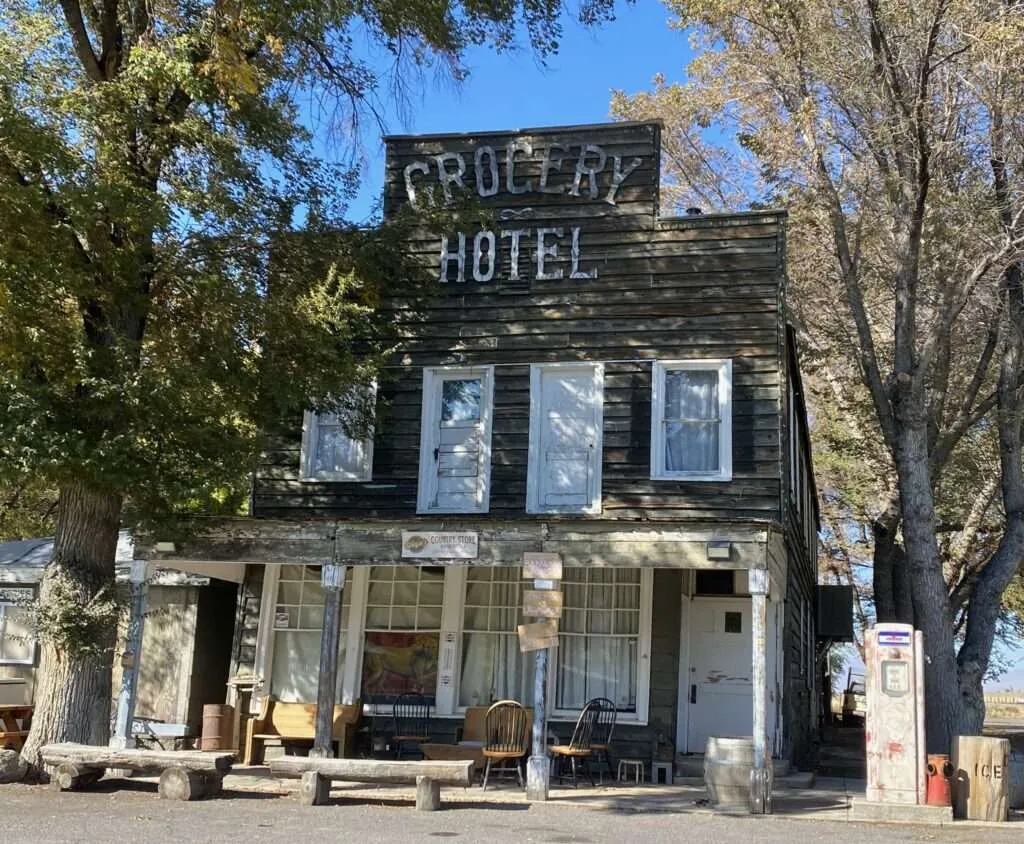 Doyle, California town sign
Doyle, California town sign
Exploring Ghost Towns Near Reno: A Journey Through Time
Exploring the ghost towns near Reno, particularly those linked by the story of the N.C.O. Railway and early pioneer trails, offers a compelling journey through the history of the American West. From ambitious railway projects and philosophical settlements to towns bypassed by progress and unique architectural relics, each site adds a layer to the rich tapestry of the region. These abandoned places, while sometimes desolate, are full of stories waiting to be discovered, providing a tangible connection to the past and a deeper understanding of the forces that shape communities.
Frequently Asked Questions About Ghost Towns Near Reno
What are some of the closest ghost towns near Reno?
While some ghost towns explored here are a few hours’ drive, locations like Milford, Standish, Litchfield, and Doyle in Lassen County, California, are among the more accessible historical sites relative to Reno, often within a 1-2 hour drive or part of a manageable day trip loop. Termo, Madeline, and Wendel are a bit further but still part of the regional exploration centered around the N.C.O. history originating in Reno.
Are ghost towns near Reno safe to visit?
Most accessible ghost town sites are generally safe, but it’s crucial to exercise caution. Abandoned buildings can be unstable, with crumbling floors, walls, and roofs. Always watch your step, be aware of potential hazards like broken glass or sharp objects, and never enter structures that look unsafe. Be mindful of private property boundaries, as some ruins or buildings may be on private land. It’s also wise to be prepared for rugged terrain and variable weather conditions.
What should I bring when visiting ghost towns near Reno?
Essential items include sturdy walking shoes or boots, water, snacks, sunscreen, a hat, and layers of clothing. A map or GPS is helpful as cell service can be spotty in remote areas. A camera is a must to capture the unique sights. History enthusiasts might bring a notebook or guidebooks about the region. [internal_links]
What’s the best time of year to explore ghost towns near Reno?
Spring and Fall typically offer the most pleasant weather for exploring, with mild temperatures. Summer can be very hot in this region, so early morning or late afternoon visits are recommended. Winter can bring snow and ice, making some sites inaccessible or hazardous.
Do these ghost towns have facilities like restrooms or gas stations?
Most genuine ghost town sites do not have any facilities. You should plan accordingly by fueling up your vehicle and using restrooms in nearby towns like Susanville, Alturas, or smaller communities that still have services before heading into more remote areas. Carry everything you need in and pack everything out. [internal_links]
Are there any guided tours of ghost towns near Reno?
While specific guided tours directly from Reno focusing solely on these particular ghost towns might be limited, historical societies or local tourism offices in towns like Susanville or Alturas may offer information, maps, or occasionally arrange tours focusing on the regional history, including some ghost towns or historical ruins. Independent exploration is the most common way to experience these sites.
